Ethical And Sustainable Fashion
VerifiedAdded on 2022/08/20
|24
|5916
|11
Assignment
AI Summary
Contribute Materials
Your contribution can guide someone’s learning journey. Share your
documents today.
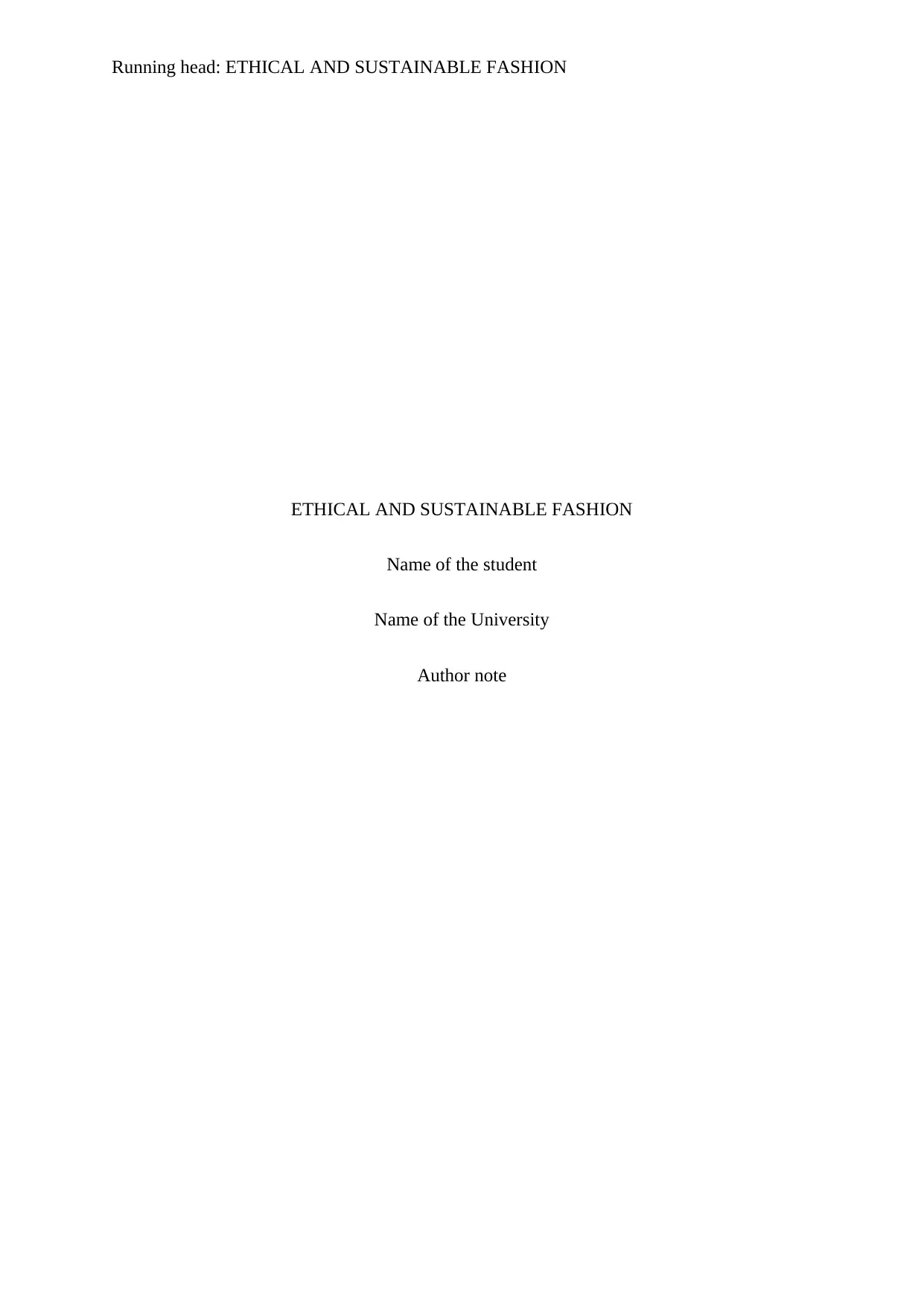
Running head: ETHICAL AND SUSTAINABLE FASHION
ETHICAL AND SUSTAINABLE FASHION
Name of the student
Name of the University
Author note
ETHICAL AND SUSTAINABLE FASHION
Name of the student
Name of the University
Author note
Secure Best Marks with AI Grader
Need help grading? Try our AI Grader for instant feedback on your assignments.
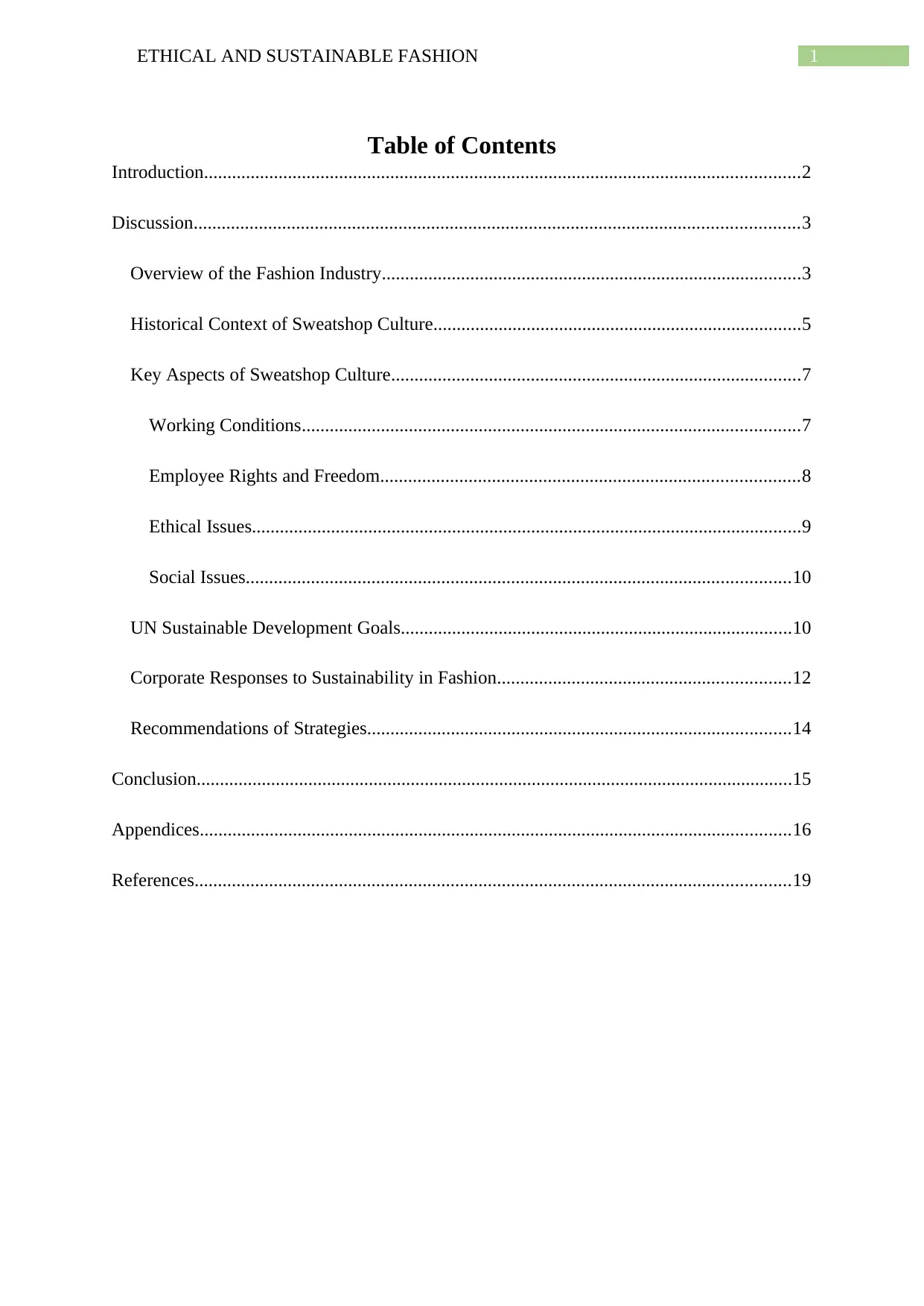
1ETHICAL AND SUSTAINABLE FASHION
Table of Contents
Introduction................................................................................................................................2
Discussion..................................................................................................................................3
Overview of the Fashion Industry..........................................................................................3
Historical Context of Sweatshop Culture...............................................................................5
Key Aspects of Sweatshop Culture........................................................................................7
Working Conditions...........................................................................................................7
Employee Rights and Freedom..........................................................................................8
Ethical Issues......................................................................................................................9
Social Issues.....................................................................................................................10
UN Sustainable Development Goals....................................................................................10
Corporate Responses to Sustainability in Fashion...............................................................12
Recommendations of Strategies...........................................................................................14
Conclusion................................................................................................................................15
Appendices...............................................................................................................................16
References................................................................................................................................19
Table of Contents
Introduction................................................................................................................................2
Discussion..................................................................................................................................3
Overview of the Fashion Industry..........................................................................................3
Historical Context of Sweatshop Culture...............................................................................5
Key Aspects of Sweatshop Culture........................................................................................7
Working Conditions...........................................................................................................7
Employee Rights and Freedom..........................................................................................8
Ethical Issues......................................................................................................................9
Social Issues.....................................................................................................................10
UN Sustainable Development Goals....................................................................................10
Corporate Responses to Sustainability in Fashion...............................................................12
Recommendations of Strategies...........................................................................................14
Conclusion................................................................................................................................15
Appendices...............................................................................................................................16
References................................................................................................................................19
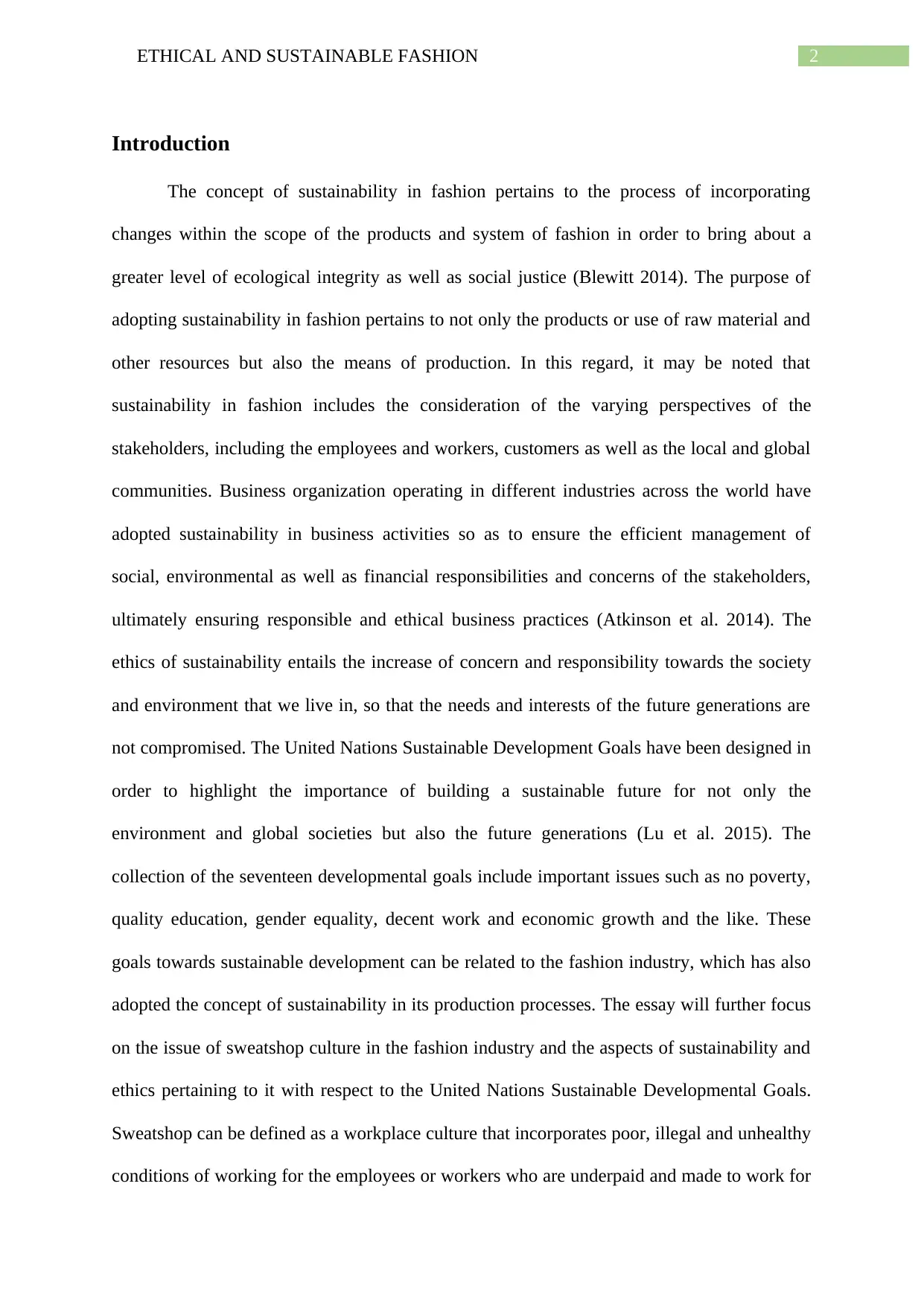
2ETHICAL AND SUSTAINABLE FASHION
Introduction
The concept of sustainability in fashion pertains to the process of incorporating
changes within the scope of the products and system of fashion in order to bring about a
greater level of ecological integrity as well as social justice (Blewitt 2014). The purpose of
adopting sustainability in fashion pertains to not only the products or use of raw material and
other resources but also the means of production. In this regard, it may be noted that
sustainability in fashion includes the consideration of the varying perspectives of the
stakeholders, including the employees and workers, customers as well as the local and global
communities. Business organization operating in different industries across the world have
adopted sustainability in business activities so as to ensure the efficient management of
social, environmental as well as financial responsibilities and concerns of the stakeholders,
ultimately ensuring responsible and ethical business practices (Atkinson et al. 2014). The
ethics of sustainability entails the increase of concern and responsibility towards the society
and environment that we live in, so that the needs and interests of the future generations are
not compromised. The United Nations Sustainable Development Goals have been designed in
order to highlight the importance of building a sustainable future for not only the
environment and global societies but also the future generations (Lu et al. 2015). The
collection of the seventeen developmental goals include important issues such as no poverty,
quality education, gender equality, decent work and economic growth and the like. These
goals towards sustainable development can be related to the fashion industry, which has also
adopted the concept of sustainability in its production processes. The essay will further focus
on the issue of sweatshop culture in the fashion industry and the aspects of sustainability and
ethics pertaining to it with respect to the United Nations Sustainable Developmental Goals.
Sweatshop can be defined as a workplace culture that incorporates poor, illegal and unhealthy
conditions of working for the employees or workers who are underpaid and made to work for
Introduction
The concept of sustainability in fashion pertains to the process of incorporating
changes within the scope of the products and system of fashion in order to bring about a
greater level of ecological integrity as well as social justice (Blewitt 2014). The purpose of
adopting sustainability in fashion pertains to not only the products or use of raw material and
other resources but also the means of production. In this regard, it may be noted that
sustainability in fashion includes the consideration of the varying perspectives of the
stakeholders, including the employees and workers, customers as well as the local and global
communities. Business organization operating in different industries across the world have
adopted sustainability in business activities so as to ensure the efficient management of
social, environmental as well as financial responsibilities and concerns of the stakeholders,
ultimately ensuring responsible and ethical business practices (Atkinson et al. 2014). The
ethics of sustainability entails the increase of concern and responsibility towards the society
and environment that we live in, so that the needs and interests of the future generations are
not compromised. The United Nations Sustainable Development Goals have been designed in
order to highlight the importance of building a sustainable future for not only the
environment and global societies but also the future generations (Lu et al. 2015). The
collection of the seventeen developmental goals include important issues such as no poverty,
quality education, gender equality, decent work and economic growth and the like. These
goals towards sustainable development can be related to the fashion industry, which has also
adopted the concept of sustainability in its production processes. The essay will further focus
on the issue of sweatshop culture in the fashion industry and the aspects of sustainability and
ethics pertaining to it with respect to the United Nations Sustainable Developmental Goals.
Sweatshop can be defined as a workplace culture that incorporates poor, illegal and unhealthy
conditions of working for the employees or workers who are underpaid and made to work for
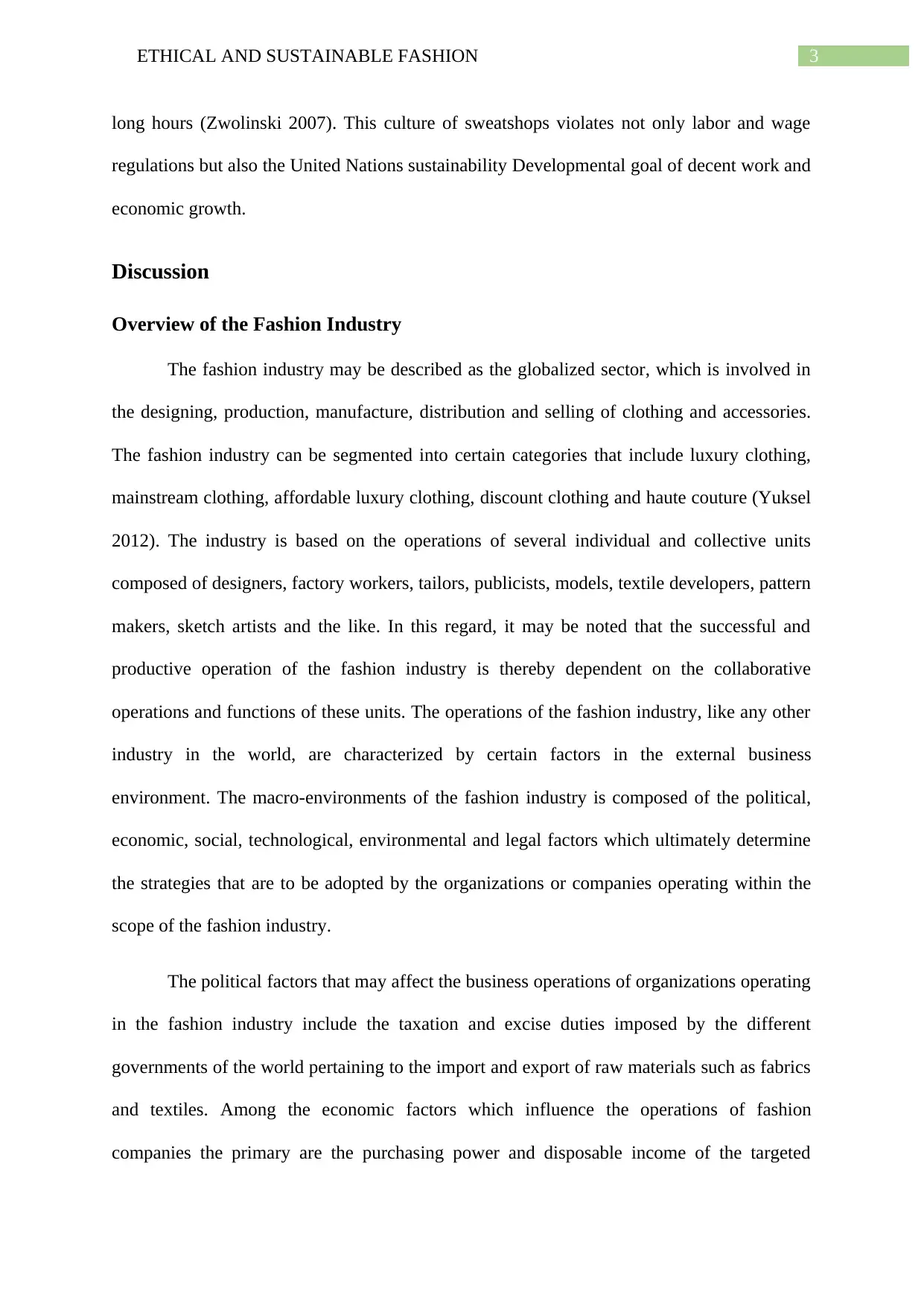
3ETHICAL AND SUSTAINABLE FASHION
long hours (Zwolinski 2007). This culture of sweatshops violates not only labor and wage
regulations but also the United Nations sustainability Developmental goal of decent work and
economic growth.
Discussion
Overview of the Fashion Industry
The fashion industry may be described as the globalized sector, which is involved in
the designing, production, manufacture, distribution and selling of clothing and accessories.
The fashion industry can be segmented into certain categories that include luxury clothing,
mainstream clothing, affordable luxury clothing, discount clothing and haute couture (Yuksel
2012). The industry is based on the operations of several individual and collective units
composed of designers, factory workers, tailors, publicists, models, textile developers, pattern
makers, sketch artists and the like. In this regard, it may be noted that the successful and
productive operation of the fashion industry is thereby dependent on the collaborative
operations and functions of these units. The operations of the fashion industry, like any other
industry in the world, are characterized by certain factors in the external business
environment. The macro-environments of the fashion industry is composed of the political,
economic, social, technological, environmental and legal factors which ultimately determine
the strategies that are to be adopted by the organizations or companies operating within the
scope of the fashion industry.
The political factors that may affect the business operations of organizations operating
in the fashion industry include the taxation and excise duties imposed by the different
governments of the world pertaining to the import and export of raw materials such as fabrics
and textiles. Among the economic factors which influence the operations of fashion
companies the primary are the purchasing power and disposable income of the targeted
long hours (Zwolinski 2007). This culture of sweatshops violates not only labor and wage
regulations but also the United Nations sustainability Developmental goal of decent work and
economic growth.
Discussion
Overview of the Fashion Industry
The fashion industry may be described as the globalized sector, which is involved in
the designing, production, manufacture, distribution and selling of clothing and accessories.
The fashion industry can be segmented into certain categories that include luxury clothing,
mainstream clothing, affordable luxury clothing, discount clothing and haute couture (Yuksel
2012). The industry is based on the operations of several individual and collective units
composed of designers, factory workers, tailors, publicists, models, textile developers, pattern
makers, sketch artists and the like. In this regard, it may be noted that the successful and
productive operation of the fashion industry is thereby dependent on the collaborative
operations and functions of these units. The operations of the fashion industry, like any other
industry in the world, are characterized by certain factors in the external business
environment. The macro-environments of the fashion industry is composed of the political,
economic, social, technological, environmental and legal factors which ultimately determine
the strategies that are to be adopted by the organizations or companies operating within the
scope of the fashion industry.
The political factors that may affect the business operations of organizations operating
in the fashion industry include the taxation and excise duties imposed by the different
governments of the world pertaining to the import and export of raw materials such as fabrics
and textiles. Among the economic factors which influence the operations of fashion
companies the primary are the purchasing power and disposable income of the targeted
Secure Best Marks with AI Grader
Need help grading? Try our AI Grader for instant feedback on your assignments.
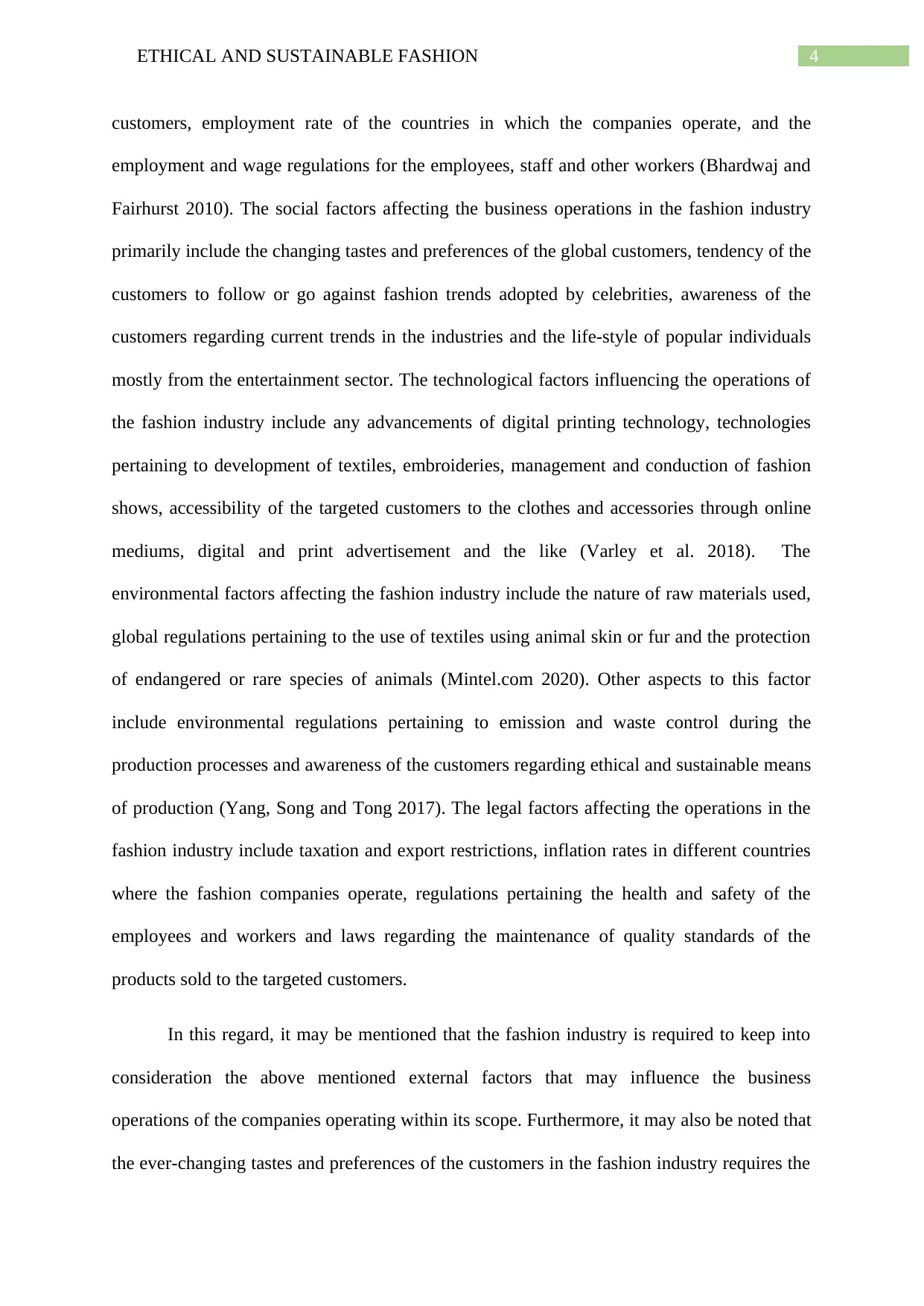
4ETHICAL AND SUSTAINABLE FASHION
customers, employment rate of the countries in which the companies operate, and the
employment and wage regulations for the employees, staff and other workers (Bhardwaj and
Fairhurst 2010). The social factors affecting the business operations in the fashion industry
primarily include the changing tastes and preferences of the global customers, tendency of the
customers to follow or go against fashion trends adopted by celebrities, awareness of the
customers regarding current trends in the industries and the life-style of popular individuals
mostly from the entertainment sector. The technological factors influencing the operations of
the fashion industry include any advancements of digital printing technology, technologies
pertaining to development of textiles, embroideries, management and conduction of fashion
shows, accessibility of the targeted customers to the clothes and accessories through online
mediums, digital and print advertisement and the like (Varley et al. 2018). The
environmental factors affecting the fashion industry include the nature of raw materials used,
global regulations pertaining to the use of textiles using animal skin or fur and the protection
of endangered or rare species of animals (Mintel.com 2020). Other aspects to this factor
include environmental regulations pertaining to emission and waste control during the
production processes and awareness of the customers regarding ethical and sustainable means
of production (Yang, Song and Tong 2017). The legal factors affecting the operations in the
fashion industry include taxation and export restrictions, inflation rates in different countries
where the fashion companies operate, regulations pertaining the health and safety of the
employees and workers and laws regarding the maintenance of quality standards of the
products sold to the targeted customers.
In this regard, it may be mentioned that the fashion industry is required to keep into
consideration the above mentioned external factors that may influence the business
operations of the companies operating within its scope. Furthermore, it may also be noted that
the ever-changing tastes and preferences of the customers in the fashion industry requires the
customers, employment rate of the countries in which the companies operate, and the
employment and wage regulations for the employees, staff and other workers (Bhardwaj and
Fairhurst 2010). The social factors affecting the business operations in the fashion industry
primarily include the changing tastes and preferences of the global customers, tendency of the
customers to follow or go against fashion trends adopted by celebrities, awareness of the
customers regarding current trends in the industries and the life-style of popular individuals
mostly from the entertainment sector. The technological factors influencing the operations of
the fashion industry include any advancements of digital printing technology, technologies
pertaining to development of textiles, embroideries, management and conduction of fashion
shows, accessibility of the targeted customers to the clothes and accessories through online
mediums, digital and print advertisement and the like (Varley et al. 2018). The
environmental factors affecting the fashion industry include the nature of raw materials used,
global regulations pertaining to the use of textiles using animal skin or fur and the protection
of endangered or rare species of animals (Mintel.com 2020). Other aspects to this factor
include environmental regulations pertaining to emission and waste control during the
production processes and awareness of the customers regarding ethical and sustainable means
of production (Yang, Song and Tong 2017). The legal factors affecting the operations in the
fashion industry include taxation and export restrictions, inflation rates in different countries
where the fashion companies operate, regulations pertaining the health and safety of the
employees and workers and laws regarding the maintenance of quality standards of the
products sold to the targeted customers.
In this regard, it may be mentioned that the fashion industry is required to keep into
consideration the above mentioned external factors that may influence the business
operations of the companies operating within its scope. Furthermore, it may also be noted that
the ever-changing tastes and preferences of the customers in the fashion industry requires the
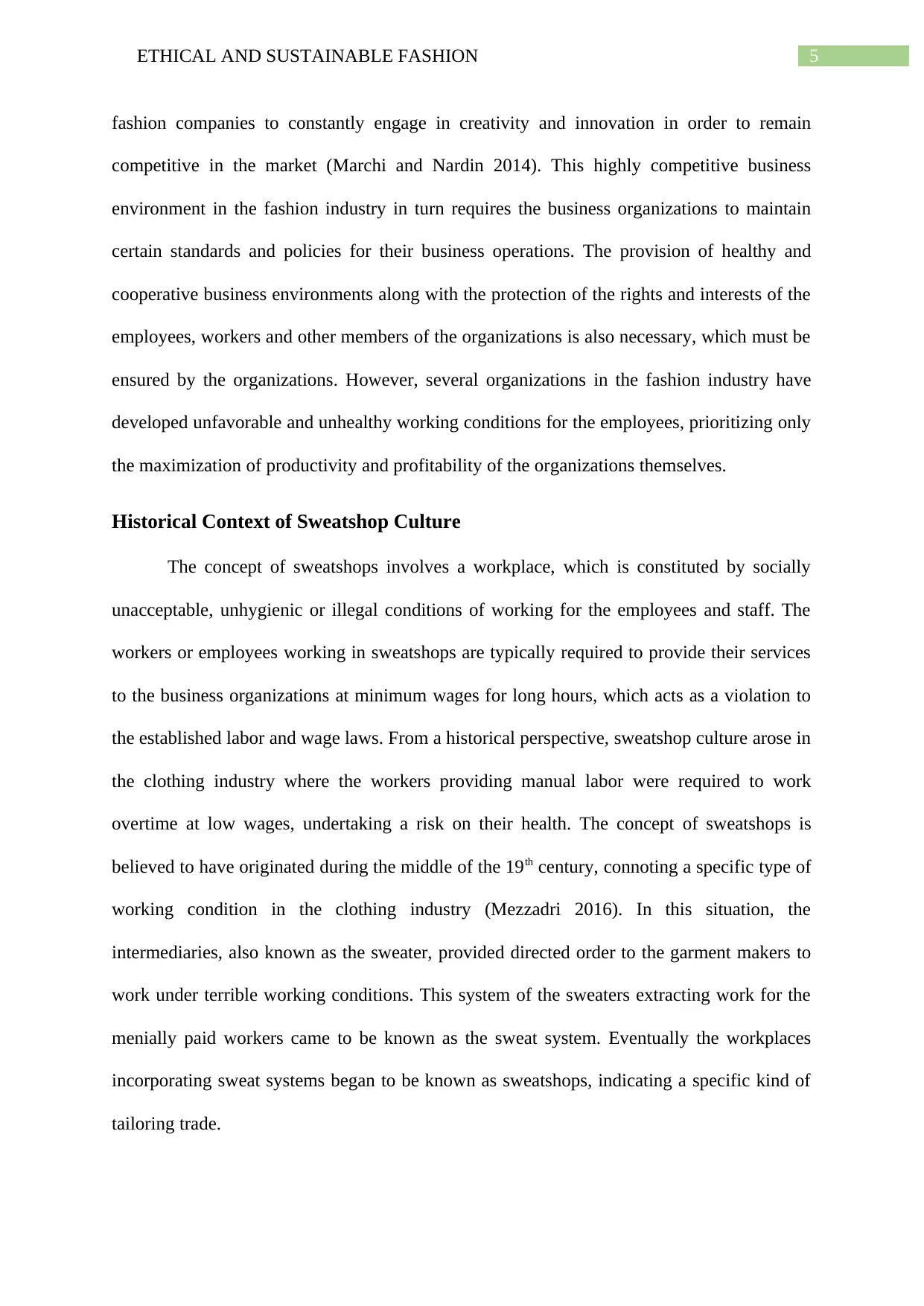
5ETHICAL AND SUSTAINABLE FASHION
fashion companies to constantly engage in creativity and innovation in order to remain
competitive in the market (Marchi and Nardin 2014). This highly competitive business
environment in the fashion industry in turn requires the business organizations to maintain
certain standards and policies for their business operations. The provision of healthy and
cooperative business environments along with the protection of the rights and interests of the
employees, workers and other members of the organizations is also necessary, which must be
ensured by the organizations. However, several organizations in the fashion industry have
developed unfavorable and unhealthy working conditions for the employees, prioritizing only
the maximization of productivity and profitability of the organizations themselves.
Historical Context of Sweatshop Culture
The concept of sweatshops involves a workplace, which is constituted by socially
unacceptable, unhygienic or illegal conditions of working for the employees and staff. The
workers or employees working in sweatshops are typically required to provide their services
to the business organizations at minimum wages for long hours, which acts as a violation to
the established labor and wage laws. From a historical perspective, sweatshop culture arose in
the clothing industry where the workers providing manual labor were required to work
overtime at low wages, undertaking a risk on their health. The concept of sweatshops is
believed to have originated during the middle of the 19th century, connoting a specific type of
working condition in the clothing industry (Mezzadri 2016). In this situation, the
intermediaries, also known as the sweater, provided directed order to the garment makers to
work under terrible working conditions. This system of the sweaters extracting work for the
menially paid workers came to be known as the sweat system. Eventually the workplaces
incorporating sweat systems began to be known as sweatshops, indicating a specific kind of
tailoring trade.
fashion companies to constantly engage in creativity and innovation in order to remain
competitive in the market (Marchi and Nardin 2014). This highly competitive business
environment in the fashion industry in turn requires the business organizations to maintain
certain standards and policies for their business operations. The provision of healthy and
cooperative business environments along with the protection of the rights and interests of the
employees, workers and other members of the organizations is also necessary, which must be
ensured by the organizations. However, several organizations in the fashion industry have
developed unfavorable and unhealthy working conditions for the employees, prioritizing only
the maximization of productivity and profitability of the organizations themselves.
Historical Context of Sweatshop Culture
The concept of sweatshops involves a workplace, which is constituted by socially
unacceptable, unhygienic or illegal conditions of working for the employees and staff. The
workers or employees working in sweatshops are typically required to provide their services
to the business organizations at minimum wages for long hours, which acts as a violation to
the established labor and wage laws. From a historical perspective, sweatshop culture arose in
the clothing industry where the workers providing manual labor were required to work
overtime at low wages, undertaking a risk on their health. The concept of sweatshops is
believed to have originated during the middle of the 19th century, connoting a specific type of
working condition in the clothing industry (Mezzadri 2016). In this situation, the
intermediaries, also known as the sweater, provided directed order to the garment makers to
work under terrible working conditions. This system of the sweaters extracting work for the
menially paid workers came to be known as the sweat system. Eventually the workplaces
incorporating sweat systems began to be known as sweatshops, indicating a specific kind of
tailoring trade.
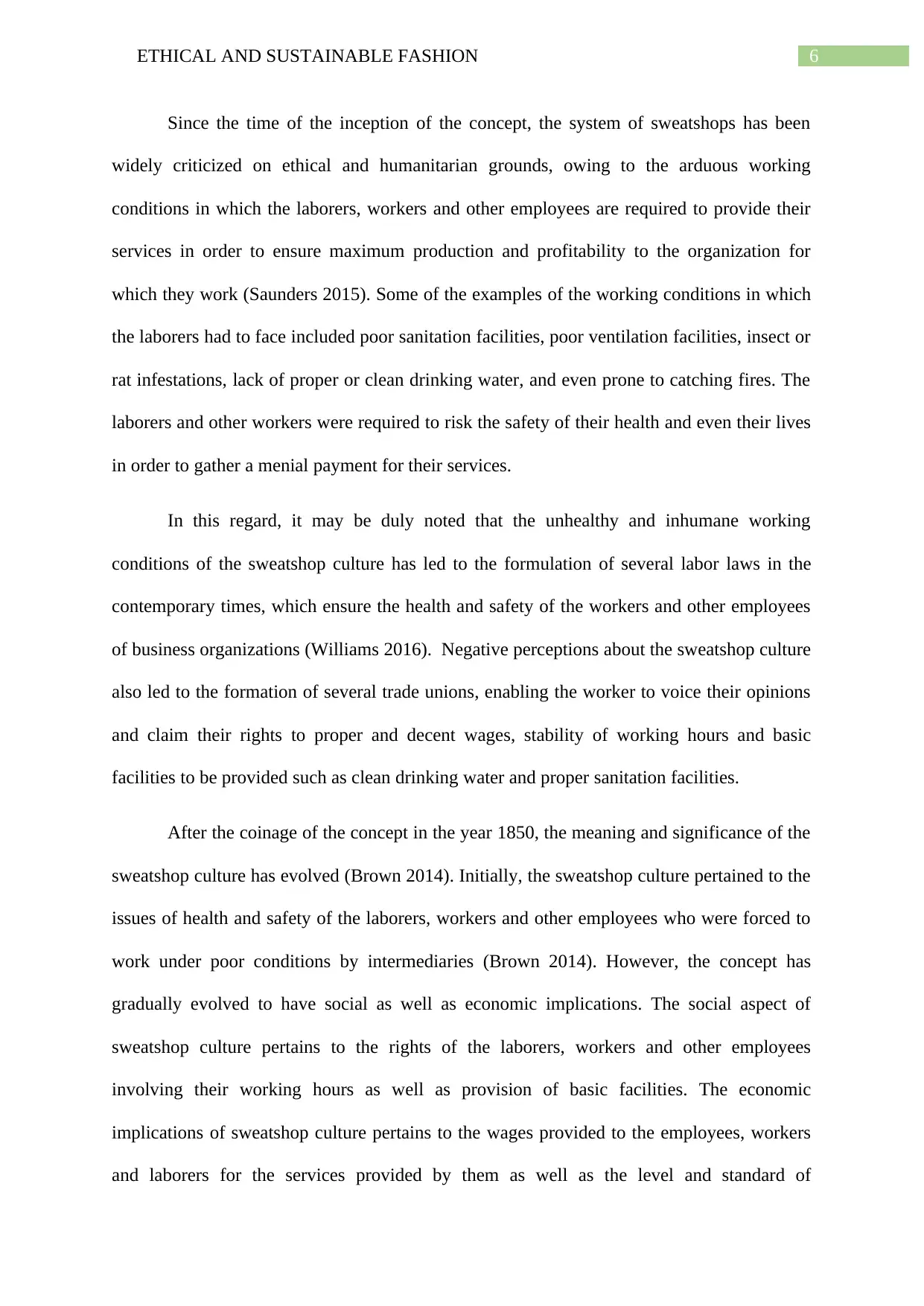
6ETHICAL AND SUSTAINABLE FASHION
Since the time of the inception of the concept, the system of sweatshops has been
widely criticized on ethical and humanitarian grounds, owing to the arduous working
conditions in which the laborers, workers and other employees are required to provide their
services in order to ensure maximum production and profitability to the organization for
which they work (Saunders 2015). Some of the examples of the working conditions in which
the laborers had to face included poor sanitation facilities, poor ventilation facilities, insect or
rat infestations, lack of proper or clean drinking water, and even prone to catching fires. The
laborers and other workers were required to risk the safety of their health and even their lives
in order to gather a menial payment for their services.
In this regard, it may be duly noted that the unhealthy and inhumane working
conditions of the sweatshop culture has led to the formulation of several labor laws in the
contemporary times, which ensure the health and safety of the workers and other employees
of business organizations (Williams 2016). Negative perceptions about the sweatshop culture
also led to the formation of several trade unions, enabling the worker to voice their opinions
and claim their rights to proper and decent wages, stability of working hours and basic
facilities to be provided such as clean drinking water and proper sanitation facilities.
After the coinage of the concept in the year 1850, the meaning and significance of the
sweatshop culture has evolved (Brown 2014). Initially, the sweatshop culture pertained to the
issues of health and safety of the laborers, workers and other employees who were forced to
work under poor conditions by intermediaries (Brown 2014). However, the concept has
gradually evolved to have social as well as economic implications. The social aspect of
sweatshop culture pertains to the rights of the laborers, workers and other employees
involving their working hours as well as provision of basic facilities. The economic
implications of sweatshop culture pertains to the wages provided to the employees, workers
and laborers for the services provided by them as well as the level and standard of
Since the time of the inception of the concept, the system of sweatshops has been
widely criticized on ethical and humanitarian grounds, owing to the arduous working
conditions in which the laborers, workers and other employees are required to provide their
services in order to ensure maximum production and profitability to the organization for
which they work (Saunders 2015). Some of the examples of the working conditions in which
the laborers had to face included poor sanitation facilities, poor ventilation facilities, insect or
rat infestations, lack of proper or clean drinking water, and even prone to catching fires. The
laborers and other workers were required to risk the safety of their health and even their lives
in order to gather a menial payment for their services.
In this regard, it may be duly noted that the unhealthy and inhumane working
conditions of the sweatshop culture has led to the formulation of several labor laws in the
contemporary times, which ensure the health and safety of the workers and other employees
of business organizations (Williams 2016). Negative perceptions about the sweatshop culture
also led to the formation of several trade unions, enabling the worker to voice their opinions
and claim their rights to proper and decent wages, stability of working hours and basic
facilities to be provided such as clean drinking water and proper sanitation facilities.
After the coinage of the concept in the year 1850, the meaning and significance of the
sweatshop culture has evolved (Brown 2014). Initially, the sweatshop culture pertained to the
issues of health and safety of the laborers, workers and other employees who were forced to
work under poor conditions by intermediaries (Brown 2014). However, the concept has
gradually evolved to have social as well as economic implications. The social aspect of
sweatshop culture pertains to the rights of the laborers, workers and other employees
involving their working hours as well as provision of basic facilities. The economic
implications of sweatshop culture pertains to the wages provided to the employees, workers
and laborers for the services provided by them as well as the level and standard of
Paraphrase This Document
Need a fresh take? Get an instant paraphrase of this document with our AI Paraphraser
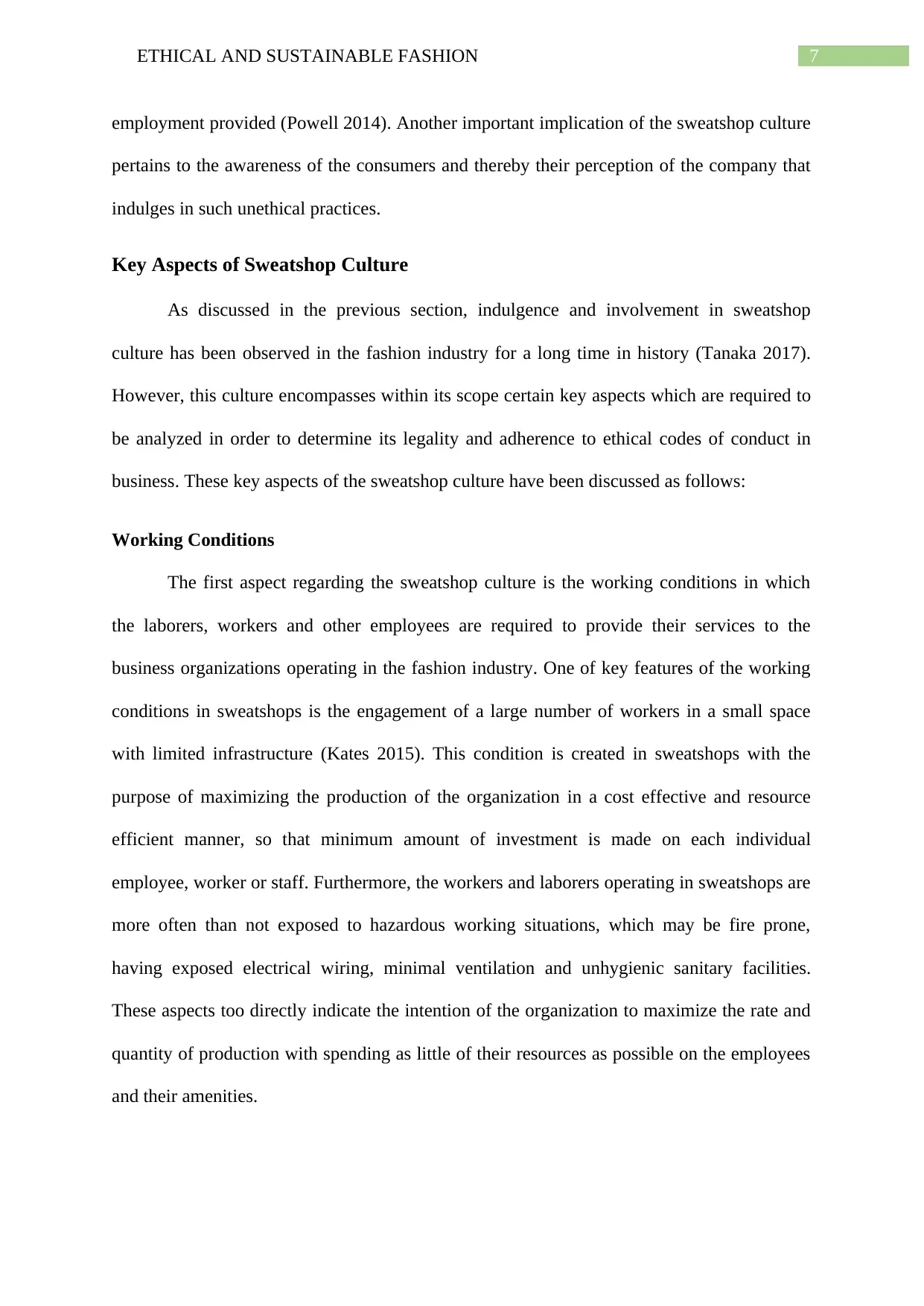
7ETHICAL AND SUSTAINABLE FASHION
employment provided (Powell 2014). Another important implication of the sweatshop culture
pertains to the awareness of the consumers and thereby their perception of the company that
indulges in such unethical practices.
Key Aspects of Sweatshop Culture
As discussed in the previous section, indulgence and involvement in sweatshop
culture has been observed in the fashion industry for a long time in history (Tanaka 2017).
However, this culture encompasses within its scope certain key aspects which are required to
be analyzed in order to determine its legality and adherence to ethical codes of conduct in
business. These key aspects of the sweatshop culture have been discussed as follows:
Working Conditions
The first aspect regarding the sweatshop culture is the working conditions in which
the laborers, workers and other employees are required to provide their services to the
business organizations operating in the fashion industry. One of key features of the working
conditions in sweatshops is the engagement of a large number of workers in a small space
with limited infrastructure (Kates 2015). This condition is created in sweatshops with the
purpose of maximizing the production of the organization in a cost effective and resource
efficient manner, so that minimum amount of investment is made on each individual
employee, worker or staff. Furthermore, the workers and laborers operating in sweatshops are
more often than not exposed to hazardous working situations, which may be fire prone,
having exposed electrical wiring, minimal ventilation and unhygienic sanitary facilities.
These aspects too directly indicate the intention of the organization to maximize the rate and
quantity of production with spending as little of their resources as possible on the employees
and their amenities.
employment provided (Powell 2014). Another important implication of the sweatshop culture
pertains to the awareness of the consumers and thereby their perception of the company that
indulges in such unethical practices.
Key Aspects of Sweatshop Culture
As discussed in the previous section, indulgence and involvement in sweatshop
culture has been observed in the fashion industry for a long time in history (Tanaka 2017).
However, this culture encompasses within its scope certain key aspects which are required to
be analyzed in order to determine its legality and adherence to ethical codes of conduct in
business. These key aspects of the sweatshop culture have been discussed as follows:
Working Conditions
The first aspect regarding the sweatshop culture is the working conditions in which
the laborers, workers and other employees are required to provide their services to the
business organizations operating in the fashion industry. One of key features of the working
conditions in sweatshops is the engagement of a large number of workers in a small space
with limited infrastructure (Kates 2015). This condition is created in sweatshops with the
purpose of maximizing the production of the organization in a cost effective and resource
efficient manner, so that minimum amount of investment is made on each individual
employee, worker or staff. Furthermore, the workers and laborers operating in sweatshops are
more often than not exposed to hazardous working situations, which may be fire prone,
having exposed electrical wiring, minimal ventilation and unhygienic sanitary facilities.
These aspects too directly indicate the intention of the organization to maximize the rate and
quantity of production with spending as little of their resources as possible on the employees
and their amenities.
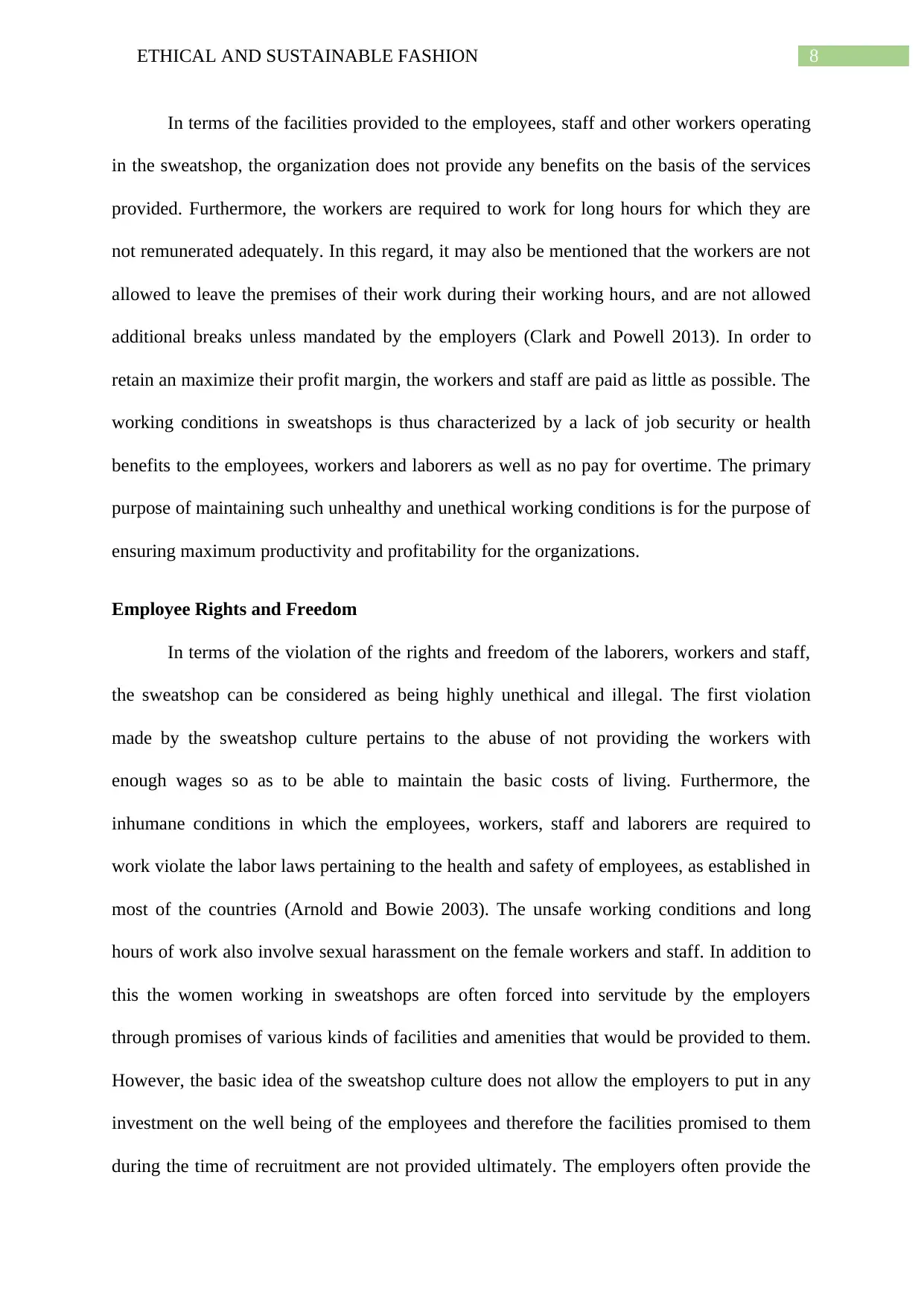
8ETHICAL AND SUSTAINABLE FASHION
In terms of the facilities provided to the employees, staff and other workers operating
in the sweatshop, the organization does not provide any benefits on the basis of the services
provided. Furthermore, the workers are required to work for long hours for which they are
not remunerated adequately. In this regard, it may also be mentioned that the workers are not
allowed to leave the premises of their work during their working hours, and are not allowed
additional breaks unless mandated by the employers (Clark and Powell 2013). In order to
retain an maximize their profit margin, the workers and staff are paid as little as possible. The
working conditions in sweatshops is thus characterized by a lack of job security or health
benefits to the employees, workers and laborers as well as no pay for overtime. The primary
purpose of maintaining such unhealthy and unethical working conditions is for the purpose of
ensuring maximum productivity and profitability for the organizations.
Employee Rights and Freedom
In terms of the violation of the rights and freedom of the laborers, workers and staff,
the sweatshop can be considered as being highly unethical and illegal. The first violation
made by the sweatshop culture pertains to the abuse of not providing the workers with
enough wages so as to be able to maintain the basic costs of living. Furthermore, the
inhumane conditions in which the employees, workers, staff and laborers are required to
work violate the labor laws pertaining to the health and safety of employees, as established in
most of the countries (Arnold and Bowie 2003). The unsafe working conditions and long
hours of work also involve sexual harassment on the female workers and staff. In addition to
this the women working in sweatshops are often forced into servitude by the employers
through promises of various kinds of facilities and amenities that would be provided to them.
However, the basic idea of the sweatshop culture does not allow the employers to put in any
investment on the well being of the employees and therefore the facilities promised to them
during the time of recruitment are not provided ultimately. The employers often provide the
In terms of the facilities provided to the employees, staff and other workers operating
in the sweatshop, the organization does not provide any benefits on the basis of the services
provided. Furthermore, the workers are required to work for long hours for which they are
not remunerated adequately. In this regard, it may also be mentioned that the workers are not
allowed to leave the premises of their work during their working hours, and are not allowed
additional breaks unless mandated by the employers (Clark and Powell 2013). In order to
retain an maximize their profit margin, the workers and staff are paid as little as possible. The
working conditions in sweatshops is thus characterized by a lack of job security or health
benefits to the employees, workers and laborers as well as no pay for overtime. The primary
purpose of maintaining such unhealthy and unethical working conditions is for the purpose of
ensuring maximum productivity and profitability for the organizations.
Employee Rights and Freedom
In terms of the violation of the rights and freedom of the laborers, workers and staff,
the sweatshop can be considered as being highly unethical and illegal. The first violation
made by the sweatshop culture pertains to the abuse of not providing the workers with
enough wages so as to be able to maintain the basic costs of living. Furthermore, the
inhumane conditions in which the employees, workers, staff and laborers are required to
work violate the labor laws pertaining to the health and safety of employees, as established in
most of the countries (Arnold and Bowie 2003). The unsafe working conditions and long
hours of work also involve sexual harassment on the female workers and staff. In addition to
this the women working in sweatshops are often forced into servitude by the employers
through promises of various kinds of facilities and amenities that would be provided to them.
However, the basic idea of the sweatshop culture does not allow the employers to put in any
investment on the well being of the employees and therefore the facilities promised to them
during the time of recruitment are not provided ultimately. The employers often provide the
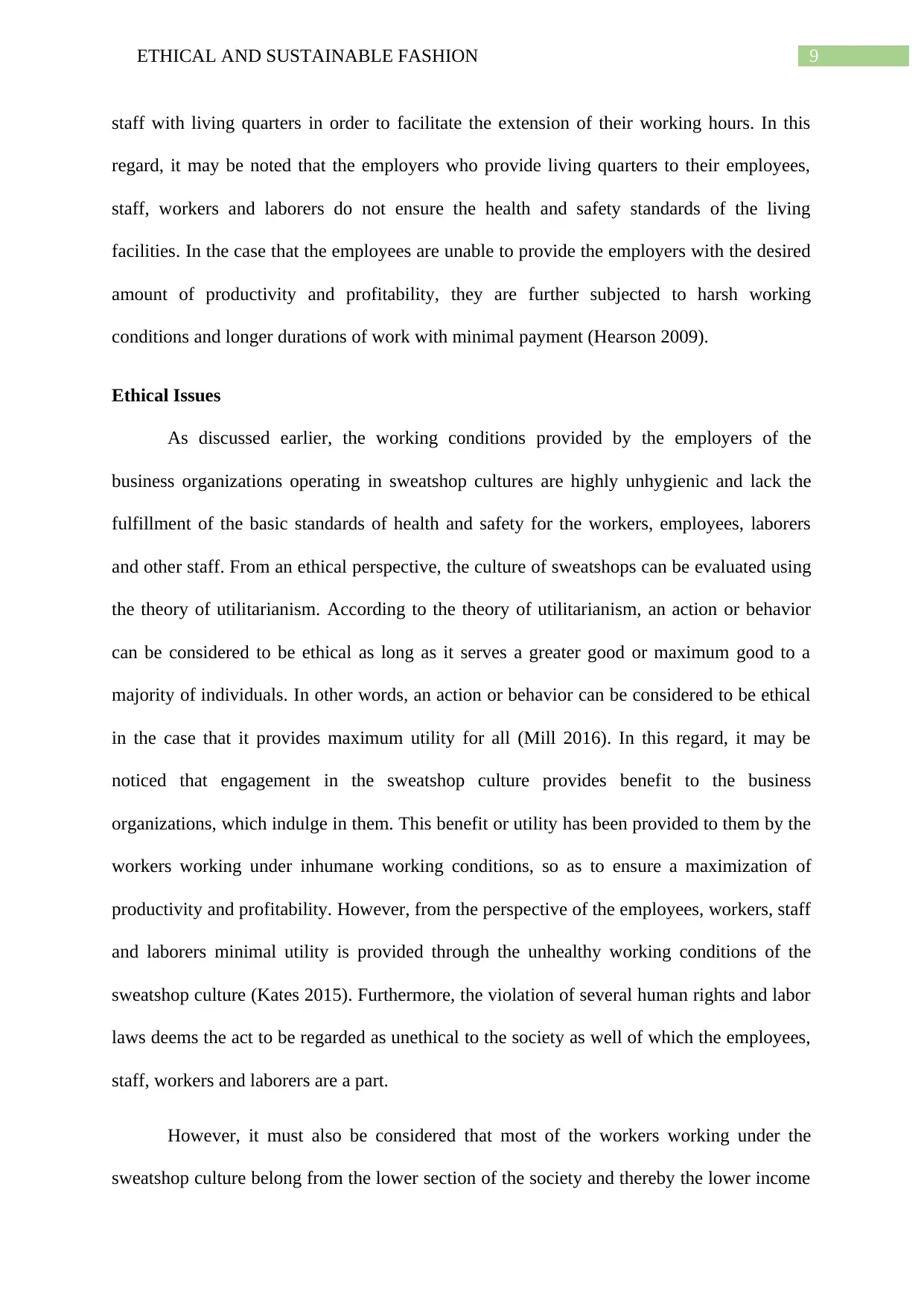
9ETHICAL AND SUSTAINABLE FASHION
staff with living quarters in order to facilitate the extension of their working hours. In this
regard, it may be noted that the employers who provide living quarters to their employees,
staff, workers and laborers do not ensure the health and safety standards of the living
facilities. In the case that the employees are unable to provide the employers with the desired
amount of productivity and profitability, they are further subjected to harsh working
conditions and longer durations of work with minimal payment (Hearson 2009).
Ethical Issues
As discussed earlier, the working conditions provided by the employers of the
business organizations operating in sweatshop cultures are highly unhygienic and lack the
fulfillment of the basic standards of health and safety for the workers, employees, laborers
and other staff. From an ethical perspective, the culture of sweatshops can be evaluated using
the theory of utilitarianism. According to the theory of utilitarianism, an action or behavior
can be considered to be ethical as long as it serves a greater good or maximum good to a
majority of individuals. In other words, an action or behavior can be considered to be ethical
in the case that it provides maximum utility for all (Mill 2016). In this regard, it may be
noticed that engagement in the sweatshop culture provides benefit to the business
organizations, which indulge in them. This benefit or utility has been provided to them by the
workers working under inhumane working conditions, so as to ensure a maximization of
productivity and profitability. However, from the perspective of the employees, workers, staff
and laborers minimal utility is provided through the unhealthy working conditions of the
sweatshop culture (Kates 2015). Furthermore, the violation of several human rights and labor
laws deems the act to be regarded as unethical to the society as well of which the employees,
staff, workers and laborers are a part.
However, it must also be considered that most of the workers working under the
sweatshop culture belong from the lower section of the society and thereby the lower income
staff with living quarters in order to facilitate the extension of their working hours. In this
regard, it may be noted that the employers who provide living quarters to their employees,
staff, workers and laborers do not ensure the health and safety standards of the living
facilities. In the case that the employees are unable to provide the employers with the desired
amount of productivity and profitability, they are further subjected to harsh working
conditions and longer durations of work with minimal payment (Hearson 2009).
Ethical Issues
As discussed earlier, the working conditions provided by the employers of the
business organizations operating in sweatshop cultures are highly unhygienic and lack the
fulfillment of the basic standards of health and safety for the workers, employees, laborers
and other staff. From an ethical perspective, the culture of sweatshops can be evaluated using
the theory of utilitarianism. According to the theory of utilitarianism, an action or behavior
can be considered to be ethical as long as it serves a greater good or maximum good to a
majority of individuals. In other words, an action or behavior can be considered to be ethical
in the case that it provides maximum utility for all (Mill 2016). In this regard, it may be
noticed that engagement in the sweatshop culture provides benefit to the business
organizations, which indulge in them. This benefit or utility has been provided to them by the
workers working under inhumane working conditions, so as to ensure a maximization of
productivity and profitability. However, from the perspective of the employees, workers, staff
and laborers minimal utility is provided through the unhealthy working conditions of the
sweatshop culture (Kates 2015). Furthermore, the violation of several human rights and labor
laws deems the act to be regarded as unethical to the society as well of which the employees,
staff, workers and laborers are a part.
However, it must also be considered that most of the workers working under the
sweatshop culture belong from the lower section of the society and thereby the lower income
Secure Best Marks with AI Grader
Need help grading? Try our AI Grader for instant feedback on your assignments.
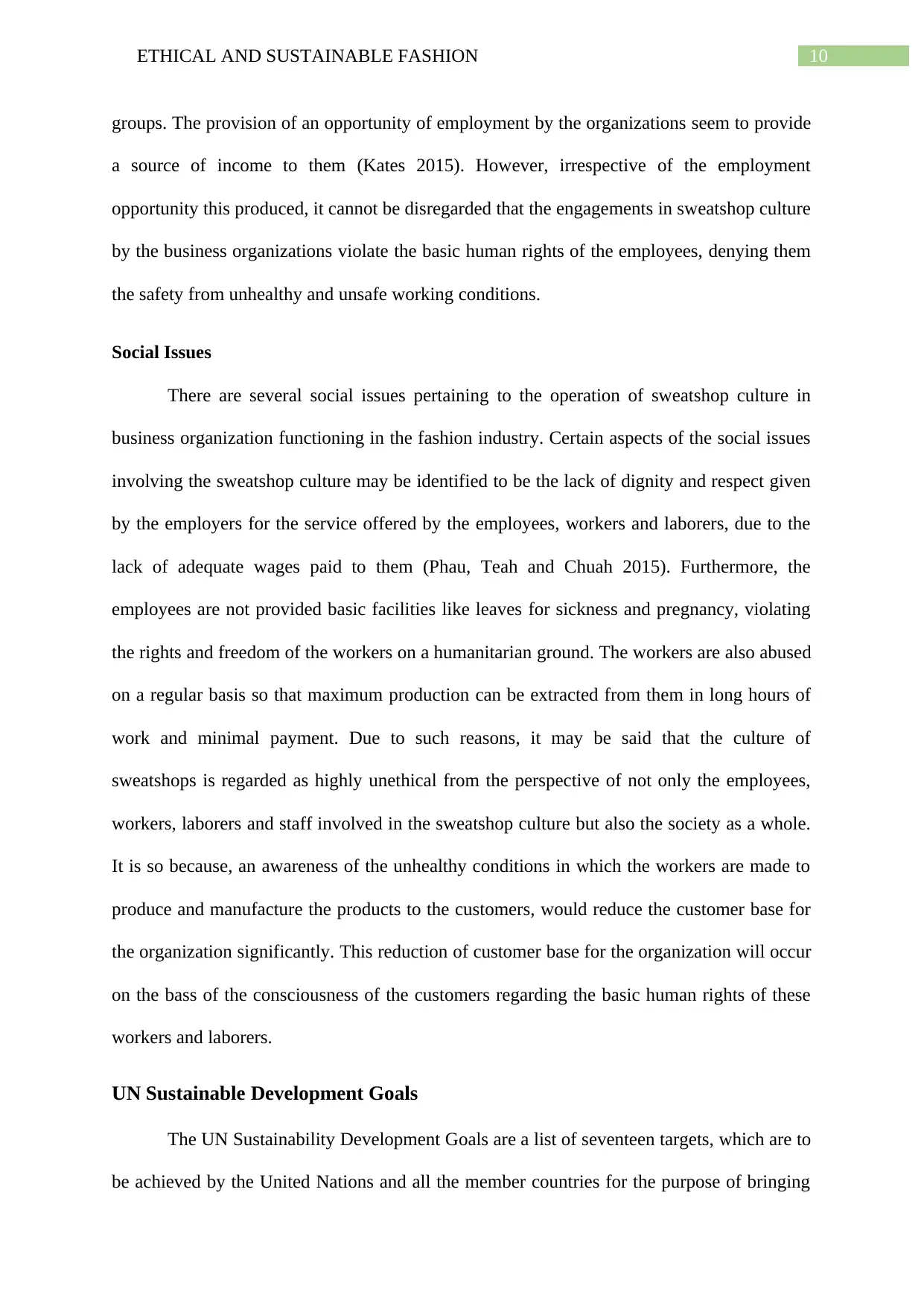
10ETHICAL AND SUSTAINABLE FASHION
groups. The provision of an opportunity of employment by the organizations seem to provide
a source of income to them (Kates 2015). However, irrespective of the employment
opportunity this produced, it cannot be disregarded that the engagements in sweatshop culture
by the business organizations violate the basic human rights of the employees, denying them
the safety from unhealthy and unsafe working conditions.
Social Issues
There are several social issues pertaining to the operation of sweatshop culture in
business organization functioning in the fashion industry. Certain aspects of the social issues
involving the sweatshop culture may be identified to be the lack of dignity and respect given
by the employers for the service offered by the employees, workers and laborers, due to the
lack of adequate wages paid to them (Phau, Teah and Chuah 2015). Furthermore, the
employees are not provided basic facilities like leaves for sickness and pregnancy, violating
the rights and freedom of the workers on a humanitarian ground. The workers are also abused
on a regular basis so that maximum production can be extracted from them in long hours of
work and minimal payment. Due to such reasons, it may be said that the culture of
sweatshops is regarded as highly unethical from the perspective of not only the employees,
workers, laborers and staff involved in the sweatshop culture but also the society as a whole.
It is so because, an awareness of the unhealthy conditions in which the workers are made to
produce and manufacture the products to the customers, would reduce the customer base for
the organization significantly. This reduction of customer base for the organization will occur
on the bass of the consciousness of the customers regarding the basic human rights of these
workers and laborers.
UN Sustainable Development Goals
The UN Sustainability Development Goals are a list of seventeen targets, which are to
be achieved by the United Nations and all the member countries for the purpose of bringing
groups. The provision of an opportunity of employment by the organizations seem to provide
a source of income to them (Kates 2015). However, irrespective of the employment
opportunity this produced, it cannot be disregarded that the engagements in sweatshop culture
by the business organizations violate the basic human rights of the employees, denying them
the safety from unhealthy and unsafe working conditions.
Social Issues
There are several social issues pertaining to the operation of sweatshop culture in
business organization functioning in the fashion industry. Certain aspects of the social issues
involving the sweatshop culture may be identified to be the lack of dignity and respect given
by the employers for the service offered by the employees, workers and laborers, due to the
lack of adequate wages paid to them (Phau, Teah and Chuah 2015). Furthermore, the
employees are not provided basic facilities like leaves for sickness and pregnancy, violating
the rights and freedom of the workers on a humanitarian ground. The workers are also abused
on a regular basis so that maximum production can be extracted from them in long hours of
work and minimal payment. Due to such reasons, it may be said that the culture of
sweatshops is regarded as highly unethical from the perspective of not only the employees,
workers, laborers and staff involved in the sweatshop culture but also the society as a whole.
It is so because, an awareness of the unhealthy conditions in which the workers are made to
produce and manufacture the products to the customers, would reduce the customer base for
the organization significantly. This reduction of customer base for the organization will occur
on the bass of the consciousness of the customers regarding the basic human rights of these
workers and laborers.
UN Sustainable Development Goals
The UN Sustainability Development Goals are a list of seventeen targets, which are to
be achieved by the United Nations and all the member countries for the purpose of bringing
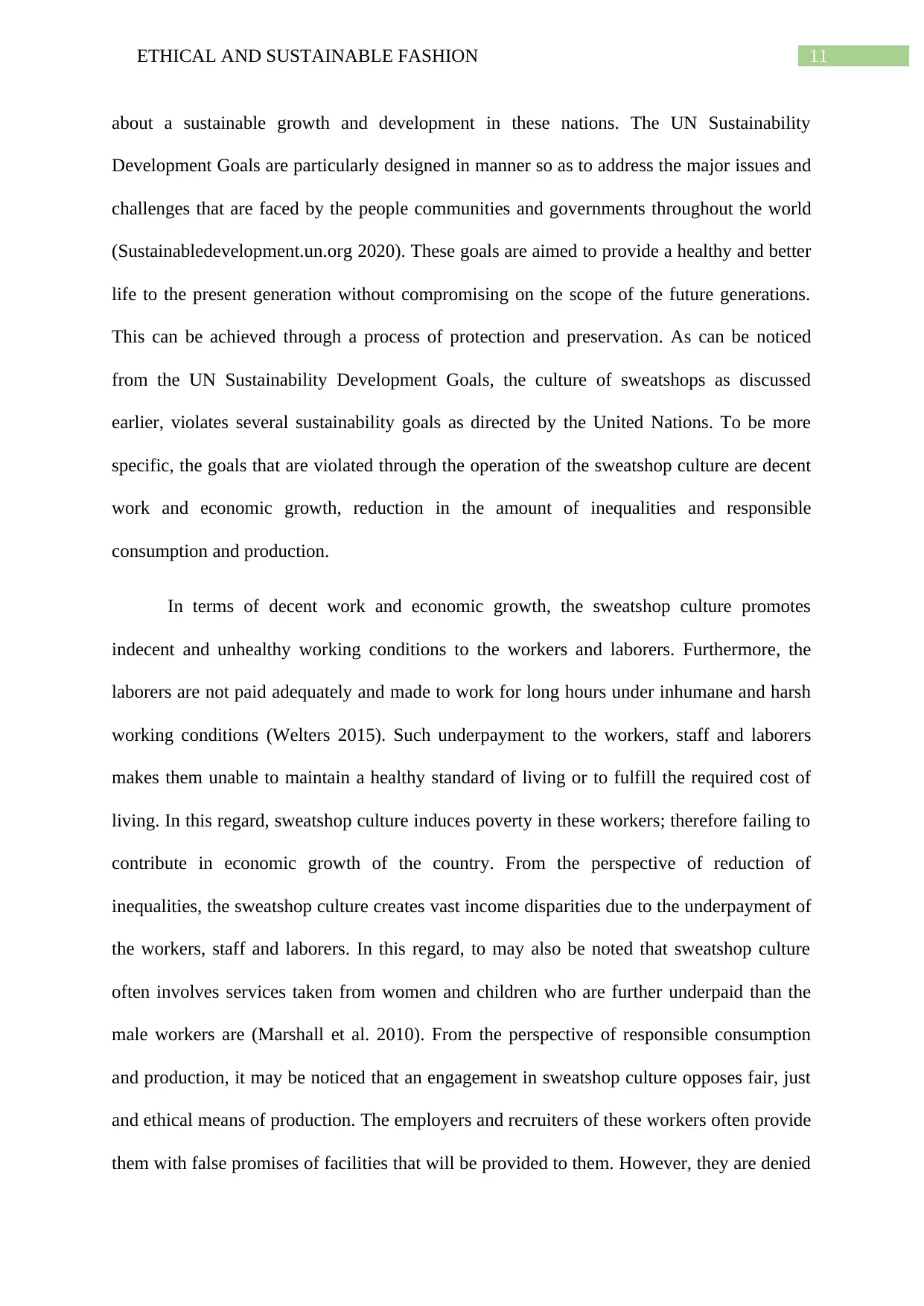
11ETHICAL AND SUSTAINABLE FASHION
about a sustainable growth and development in these nations. The UN Sustainability
Development Goals are particularly designed in manner so as to address the major issues and
challenges that are faced by the people communities and governments throughout the world
(Sustainabledevelopment.un.org 2020). These goals are aimed to provide a healthy and better
life to the present generation without compromising on the scope of the future generations.
This can be achieved through a process of protection and preservation. As can be noticed
from the UN Sustainability Development Goals, the culture of sweatshops as discussed
earlier, violates several sustainability goals as directed by the United Nations. To be more
specific, the goals that are violated through the operation of the sweatshop culture are decent
work and economic growth, reduction in the amount of inequalities and responsible
consumption and production.
In terms of decent work and economic growth, the sweatshop culture promotes
indecent and unhealthy working conditions to the workers and laborers. Furthermore, the
laborers are not paid adequately and made to work for long hours under inhumane and harsh
working conditions (Welters 2015). Such underpayment to the workers, staff and laborers
makes them unable to maintain a healthy standard of living or to fulfill the required cost of
living. In this regard, sweatshop culture induces poverty in these workers; therefore failing to
contribute in economic growth of the country. From the perspective of reduction of
inequalities, the sweatshop culture creates vast income disparities due to the underpayment of
the workers, staff and laborers. In this regard, to may also be noted that sweatshop culture
often involves services taken from women and children who are further underpaid than the
male workers are (Marshall et al. 2010). From the perspective of responsible consumption
and production, it may be noticed that an engagement in sweatshop culture opposes fair, just
and ethical means of production. The employers and recruiters of these workers often provide
them with false promises of facilities that will be provided to them. However, they are denied
about a sustainable growth and development in these nations. The UN Sustainability
Development Goals are particularly designed in manner so as to address the major issues and
challenges that are faced by the people communities and governments throughout the world
(Sustainabledevelopment.un.org 2020). These goals are aimed to provide a healthy and better
life to the present generation without compromising on the scope of the future generations.
This can be achieved through a process of protection and preservation. As can be noticed
from the UN Sustainability Development Goals, the culture of sweatshops as discussed
earlier, violates several sustainability goals as directed by the United Nations. To be more
specific, the goals that are violated through the operation of the sweatshop culture are decent
work and economic growth, reduction in the amount of inequalities and responsible
consumption and production.
In terms of decent work and economic growth, the sweatshop culture promotes
indecent and unhealthy working conditions to the workers and laborers. Furthermore, the
laborers are not paid adequately and made to work for long hours under inhumane and harsh
working conditions (Welters 2015). Such underpayment to the workers, staff and laborers
makes them unable to maintain a healthy standard of living or to fulfill the required cost of
living. In this regard, sweatshop culture induces poverty in these workers; therefore failing to
contribute in economic growth of the country. From the perspective of reduction of
inequalities, the sweatshop culture creates vast income disparities due to the underpayment of
the workers, staff and laborers. In this regard, to may also be noted that sweatshop culture
often involves services taken from women and children who are further underpaid than the
male workers are (Marshall et al. 2010). From the perspective of responsible consumption
and production, it may be noticed that an engagement in sweatshop culture opposes fair, just
and ethical means of production. The employers and recruiters of these workers often provide
them with false promises of facilities that will be provided to them. However, they are denied
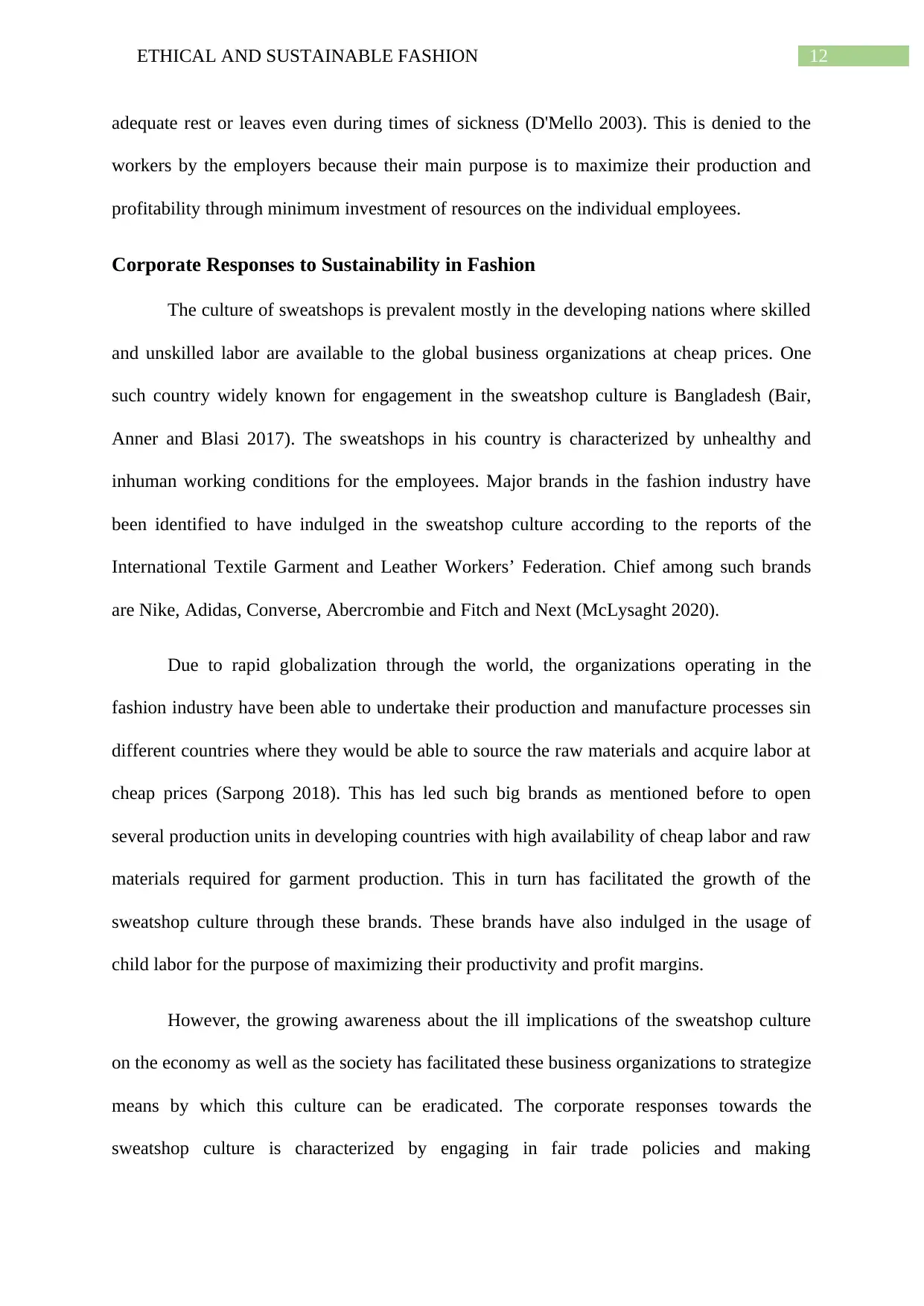
12ETHICAL AND SUSTAINABLE FASHION
adequate rest or leaves even during times of sickness (D'Mello 2003). This is denied to the
workers by the employers because their main purpose is to maximize their production and
profitability through minimum investment of resources on the individual employees.
Corporate Responses to Sustainability in Fashion
The culture of sweatshops is prevalent mostly in the developing nations where skilled
and unskilled labor are available to the global business organizations at cheap prices. One
such country widely known for engagement in the sweatshop culture is Bangladesh (Bair,
Anner and Blasi 2017). The sweatshops in his country is characterized by unhealthy and
inhuman working conditions for the employees. Major brands in the fashion industry have
been identified to have indulged in the sweatshop culture according to the reports of the
International Textile Garment and Leather Workers’ Federation. Chief among such brands
are Nike, Adidas, Converse, Abercrombie and Fitch and Next (McLysaght 2020).
Due to rapid globalization through the world, the organizations operating in the
fashion industry have been able to undertake their production and manufacture processes sin
different countries where they would be able to source the raw materials and acquire labor at
cheap prices (Sarpong 2018). This has led such big brands as mentioned before to open
several production units in developing countries with high availability of cheap labor and raw
materials required for garment production. This in turn has facilitated the growth of the
sweatshop culture through these brands. These brands have also indulged in the usage of
child labor for the purpose of maximizing their productivity and profit margins.
However, the growing awareness about the ill implications of the sweatshop culture
on the economy as well as the society has facilitated these business organizations to strategize
means by which this culture can be eradicated. The corporate responses towards the
sweatshop culture is characterized by engaging in fair trade policies and making
adequate rest or leaves even during times of sickness (D'Mello 2003). This is denied to the
workers by the employers because their main purpose is to maximize their production and
profitability through minimum investment of resources on the individual employees.
Corporate Responses to Sustainability in Fashion
The culture of sweatshops is prevalent mostly in the developing nations where skilled
and unskilled labor are available to the global business organizations at cheap prices. One
such country widely known for engagement in the sweatshop culture is Bangladesh (Bair,
Anner and Blasi 2017). The sweatshops in his country is characterized by unhealthy and
inhuman working conditions for the employees. Major brands in the fashion industry have
been identified to have indulged in the sweatshop culture according to the reports of the
International Textile Garment and Leather Workers’ Federation. Chief among such brands
are Nike, Adidas, Converse, Abercrombie and Fitch and Next (McLysaght 2020).
Due to rapid globalization through the world, the organizations operating in the
fashion industry have been able to undertake their production and manufacture processes sin
different countries where they would be able to source the raw materials and acquire labor at
cheap prices (Sarpong 2018). This has led such big brands as mentioned before to open
several production units in developing countries with high availability of cheap labor and raw
materials required for garment production. This in turn has facilitated the growth of the
sweatshop culture through these brands. These brands have also indulged in the usage of
child labor for the purpose of maximizing their productivity and profit margins.
However, the growing awareness about the ill implications of the sweatshop culture
on the economy as well as the society has facilitated these business organizations to strategize
means by which this culture can be eradicated. The corporate responses towards the
sweatshop culture is characterized by engaging in fair trade policies and making
Paraphrase This Document
Need a fresh take? Get an instant paraphrase of this document with our AI Paraphraser
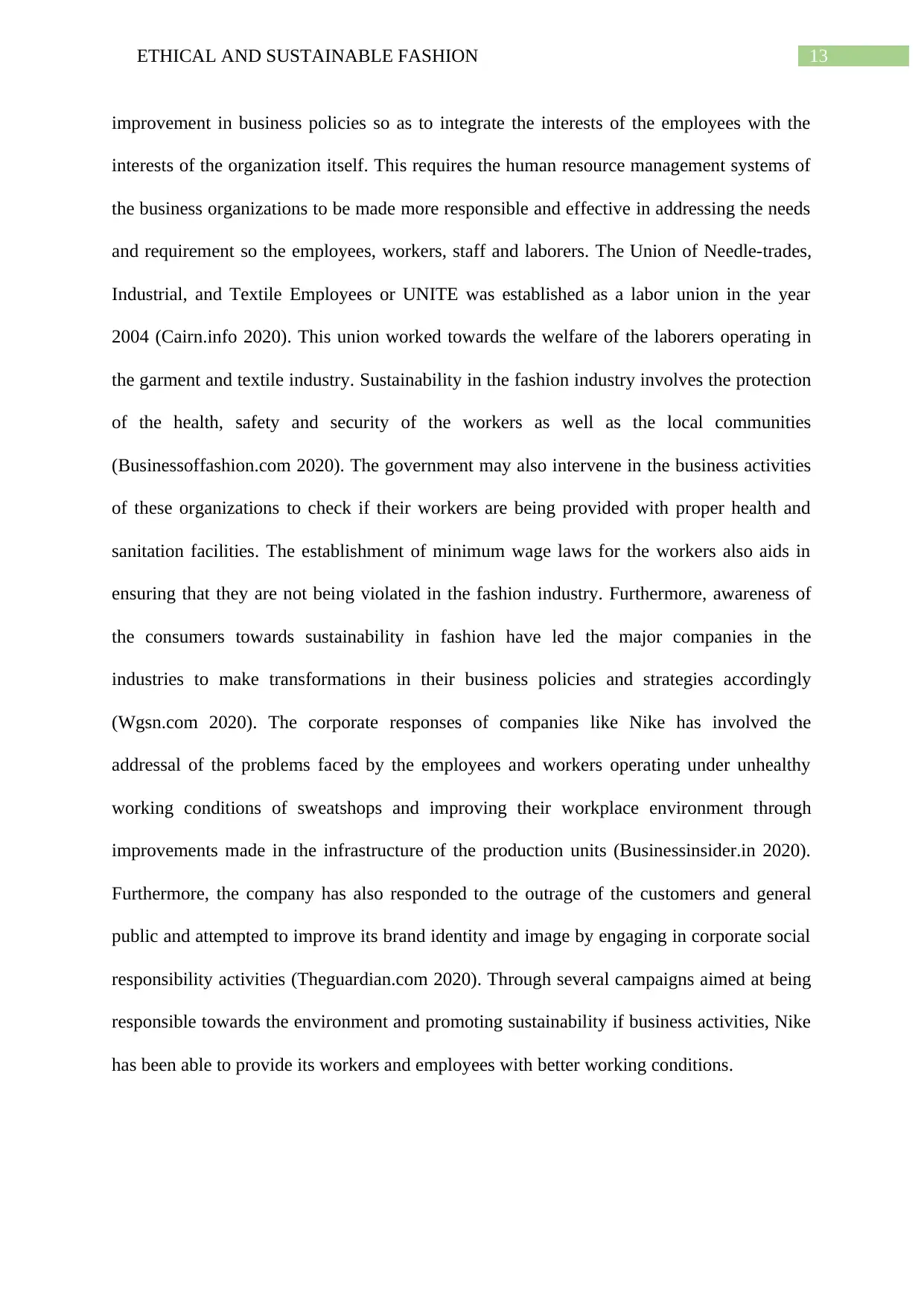
13ETHICAL AND SUSTAINABLE FASHION
improvement in business policies so as to integrate the interests of the employees with the
interests of the organization itself. This requires the human resource management systems of
the business organizations to be made more responsible and effective in addressing the needs
and requirement so the employees, workers, staff and laborers. The Union of Needle-trades,
Industrial, and Textile Employees or UNITE was established as a labor union in the year
2004 (Cairn.info 2020). This union worked towards the welfare of the laborers operating in
the garment and textile industry. Sustainability in the fashion industry involves the protection
of the health, safety and security of the workers as well as the local communities
(Businessoffashion.com 2020). The government may also intervene in the business activities
of these organizations to check if their workers are being provided with proper health and
sanitation facilities. The establishment of minimum wage laws for the workers also aids in
ensuring that they are not being violated in the fashion industry. Furthermore, awareness of
the consumers towards sustainability in fashion have led the major companies in the
industries to make transformations in their business policies and strategies accordingly
(Wgsn.com 2020). The corporate responses of companies like Nike has involved the
addressal of the problems faced by the employees and workers operating under unhealthy
working conditions of sweatshops and improving their workplace environment through
improvements made in the infrastructure of the production units (Businessinsider.in 2020).
Furthermore, the company has also responded to the outrage of the customers and general
public and attempted to improve its brand identity and image by engaging in corporate social
responsibility activities (Theguardian.com 2020). Through several campaigns aimed at being
responsible towards the environment and promoting sustainability if business activities, Nike
has been able to provide its workers and employees with better working conditions.
improvement in business policies so as to integrate the interests of the employees with the
interests of the organization itself. This requires the human resource management systems of
the business organizations to be made more responsible and effective in addressing the needs
and requirement so the employees, workers, staff and laborers. The Union of Needle-trades,
Industrial, and Textile Employees or UNITE was established as a labor union in the year
2004 (Cairn.info 2020). This union worked towards the welfare of the laborers operating in
the garment and textile industry. Sustainability in the fashion industry involves the protection
of the health, safety and security of the workers as well as the local communities
(Businessoffashion.com 2020). The government may also intervene in the business activities
of these organizations to check if their workers are being provided with proper health and
sanitation facilities. The establishment of minimum wage laws for the workers also aids in
ensuring that they are not being violated in the fashion industry. Furthermore, awareness of
the consumers towards sustainability in fashion have led the major companies in the
industries to make transformations in their business policies and strategies accordingly
(Wgsn.com 2020). The corporate responses of companies like Nike has involved the
addressal of the problems faced by the employees and workers operating under unhealthy
working conditions of sweatshops and improving their workplace environment through
improvements made in the infrastructure of the production units (Businessinsider.in 2020).
Furthermore, the company has also responded to the outrage of the customers and general
public and attempted to improve its brand identity and image by engaging in corporate social
responsibility activities (Theguardian.com 2020). Through several campaigns aimed at being
responsible towards the environment and promoting sustainability if business activities, Nike
has been able to provide its workers and employees with better working conditions.
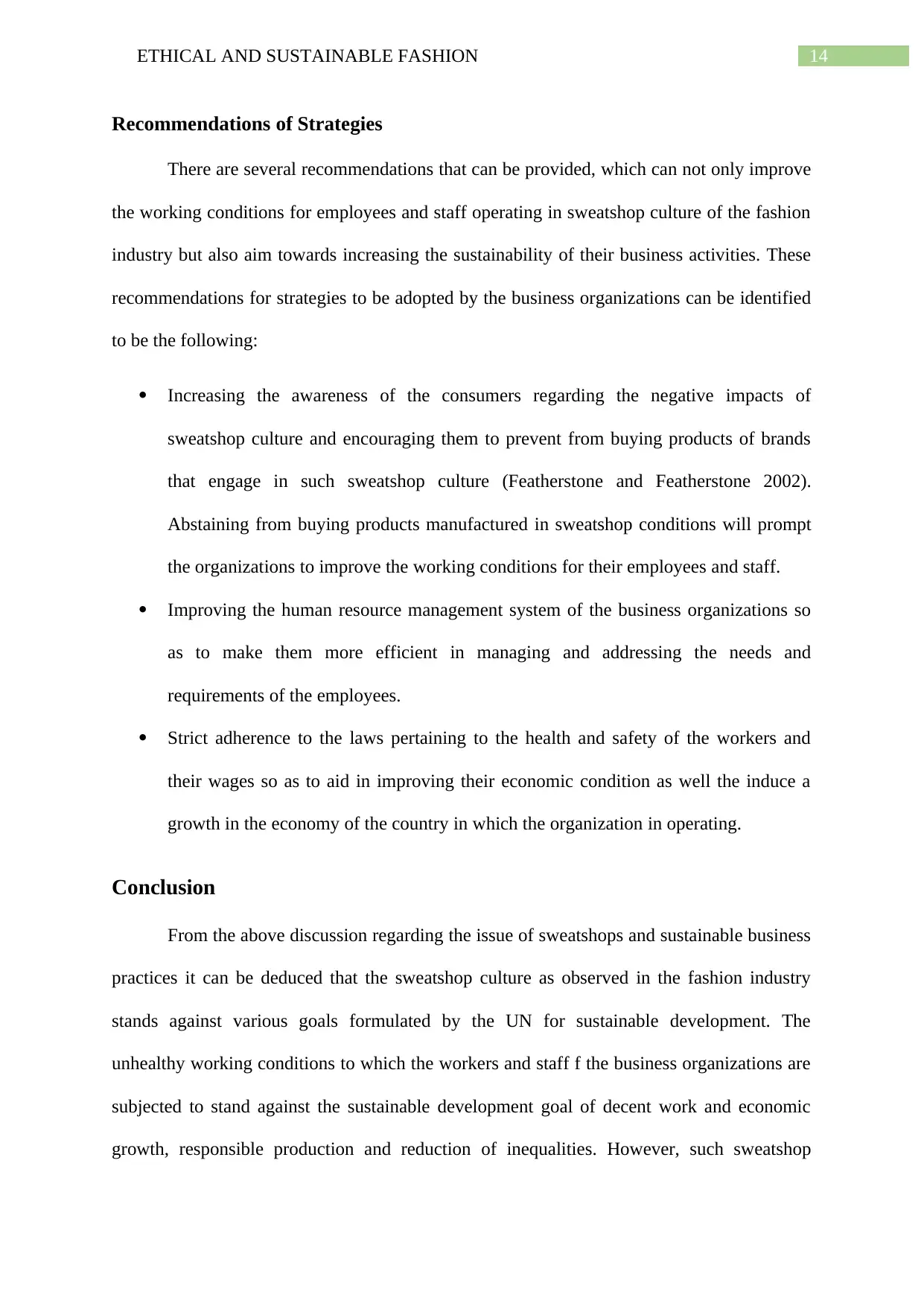
14ETHICAL AND SUSTAINABLE FASHION
Recommendations of Strategies
There are several recommendations that can be provided, which can not only improve
the working conditions for employees and staff operating in sweatshop culture of the fashion
industry but also aim towards increasing the sustainability of their business activities. These
recommendations for strategies to be adopted by the business organizations can be identified
to be the following:
Increasing the awareness of the consumers regarding the negative impacts of
sweatshop culture and encouraging them to prevent from buying products of brands
that engage in such sweatshop culture (Featherstone and Featherstone 2002).
Abstaining from buying products manufactured in sweatshop conditions will prompt
the organizations to improve the working conditions for their employees and staff.
Improving the human resource management system of the business organizations so
as to make them more efficient in managing and addressing the needs and
requirements of the employees.
Strict adherence to the laws pertaining to the health and safety of the workers and
their wages so as to aid in improving their economic condition as well the induce a
growth in the economy of the country in which the organization in operating.
Conclusion
From the above discussion regarding the issue of sweatshops and sustainable business
practices it can be deduced that the sweatshop culture as observed in the fashion industry
stands against various goals formulated by the UN for sustainable development. The
unhealthy working conditions to which the workers and staff f the business organizations are
subjected to stand against the sustainable development goal of decent work and economic
growth, responsible production and reduction of inequalities. However, such sweatshop
Recommendations of Strategies
There are several recommendations that can be provided, which can not only improve
the working conditions for employees and staff operating in sweatshop culture of the fashion
industry but also aim towards increasing the sustainability of their business activities. These
recommendations for strategies to be adopted by the business organizations can be identified
to be the following:
Increasing the awareness of the consumers regarding the negative impacts of
sweatshop culture and encouraging them to prevent from buying products of brands
that engage in such sweatshop culture (Featherstone and Featherstone 2002).
Abstaining from buying products manufactured in sweatshop conditions will prompt
the organizations to improve the working conditions for their employees and staff.
Improving the human resource management system of the business organizations so
as to make them more efficient in managing and addressing the needs and
requirements of the employees.
Strict adherence to the laws pertaining to the health and safety of the workers and
their wages so as to aid in improving their economic condition as well the induce a
growth in the economy of the country in which the organization in operating.
Conclusion
From the above discussion regarding the issue of sweatshops and sustainable business
practices it can be deduced that the sweatshop culture as observed in the fashion industry
stands against various goals formulated by the UN for sustainable development. The
unhealthy working conditions to which the workers and staff f the business organizations are
subjected to stand against the sustainable development goal of decent work and economic
growth, responsible production and reduction of inequalities. However, such sweatshop
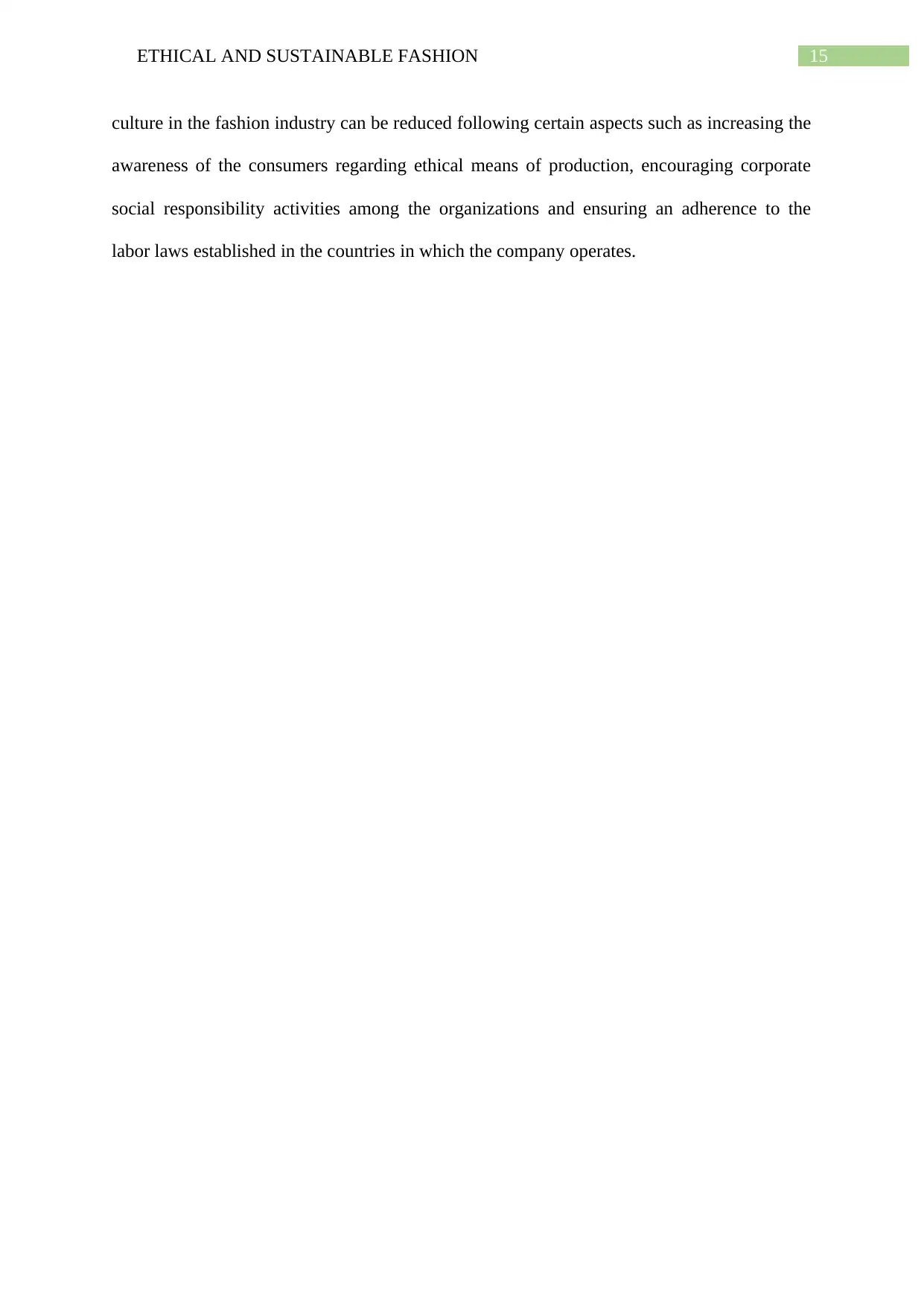
15ETHICAL AND SUSTAINABLE FASHION
culture in the fashion industry can be reduced following certain aspects such as increasing the
awareness of the consumers regarding ethical means of production, encouraging corporate
social responsibility activities among the organizations and ensuring an adherence to the
labor laws established in the countries in which the company operates.
culture in the fashion industry can be reduced following certain aspects such as increasing the
awareness of the consumers regarding ethical means of production, encouraging corporate
social responsibility activities among the organizations and ensuring an adherence to the
labor laws established in the countries in which the company operates.
Secure Best Marks with AI Grader
Need help grading? Try our AI Grader for instant feedback on your assignments.
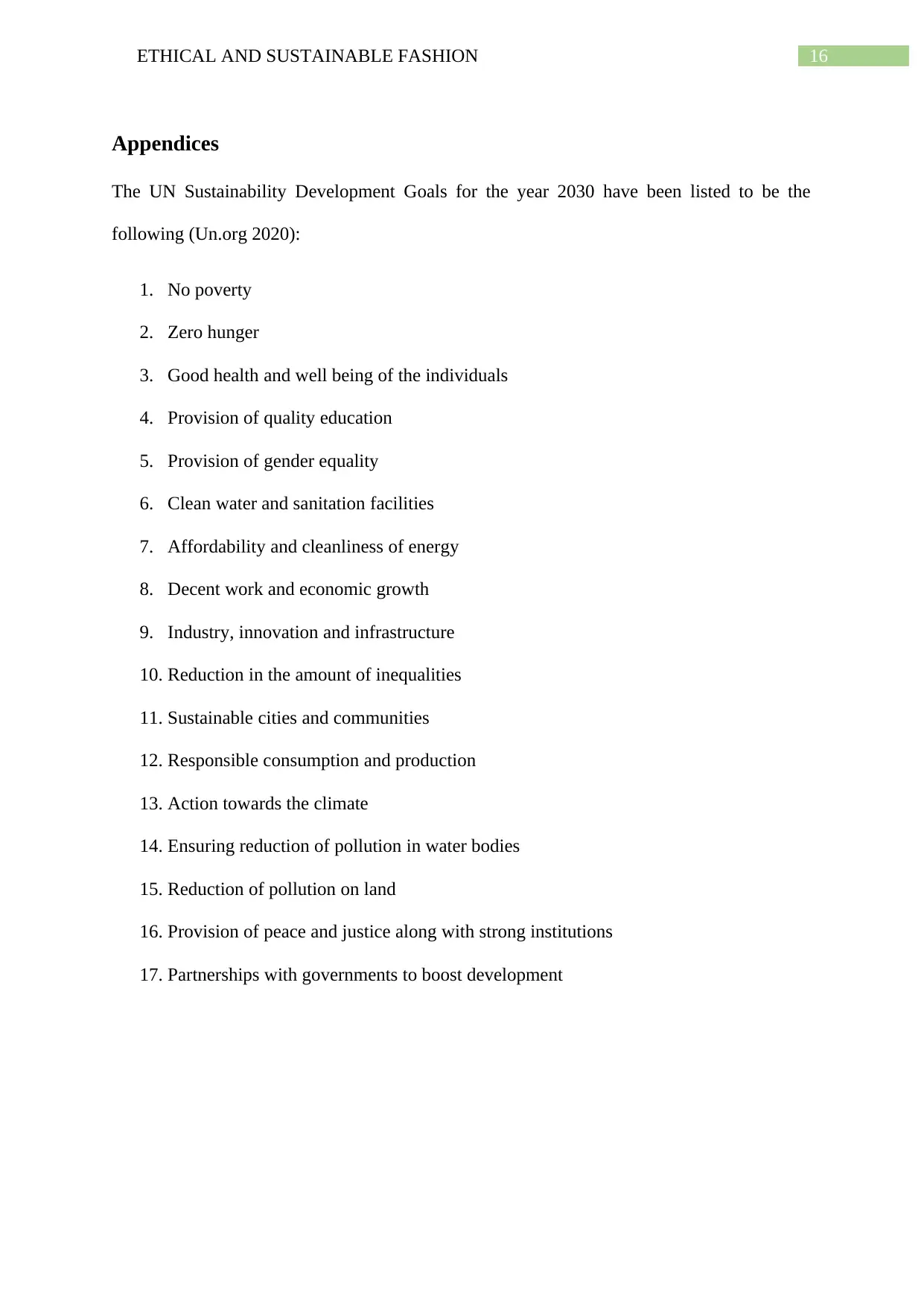
16ETHICAL AND SUSTAINABLE FASHION
Appendices
The UN Sustainability Development Goals for the year 2030 have been listed to be the
following (Un.org 2020):
1. No poverty
2. Zero hunger
3. Good health and well being of the individuals
4. Provision of quality education
5. Provision of gender equality
6. Clean water and sanitation facilities
7. Affordability and cleanliness of energy
8. Decent work and economic growth
9. Industry, innovation and infrastructure
10. Reduction in the amount of inequalities
11. Sustainable cities and communities
12. Responsible consumption and production
13. Action towards the climate
14. Ensuring reduction of pollution in water bodies
15. Reduction of pollution on land
16. Provision of peace and justice along with strong institutions
17. Partnerships with governments to boost development
Appendices
The UN Sustainability Development Goals for the year 2030 have been listed to be the
following (Un.org 2020):
1. No poverty
2. Zero hunger
3. Good health and well being of the individuals
4. Provision of quality education
5. Provision of gender equality
6. Clean water and sanitation facilities
7. Affordability and cleanliness of energy
8. Decent work and economic growth
9. Industry, innovation and infrastructure
10. Reduction in the amount of inequalities
11. Sustainable cities and communities
12. Responsible consumption and production
13. Action towards the climate
14. Ensuring reduction of pollution in water bodies
15. Reduction of pollution on land
16. Provision of peace and justice along with strong institutions
17. Partnerships with governments to boost development
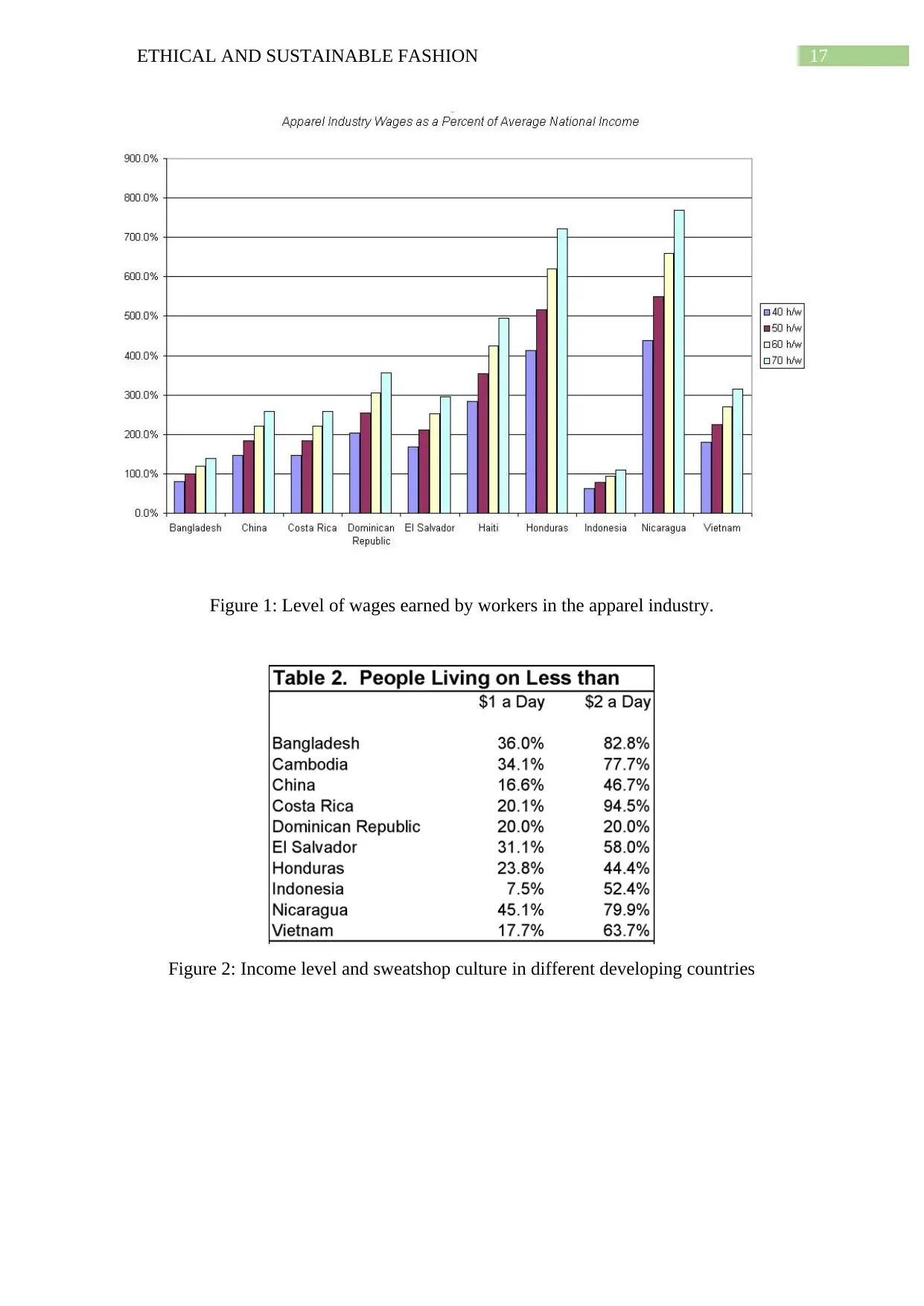
17ETHICAL AND SUSTAINABLE FASHION
Figure 1: Level of wages earned by workers in the apparel industry.
Figure 2: Income level and sweatshop culture in different developing countries
Figure 1: Level of wages earned by workers in the apparel industry.
Figure 2: Income level and sweatshop culture in different developing countries
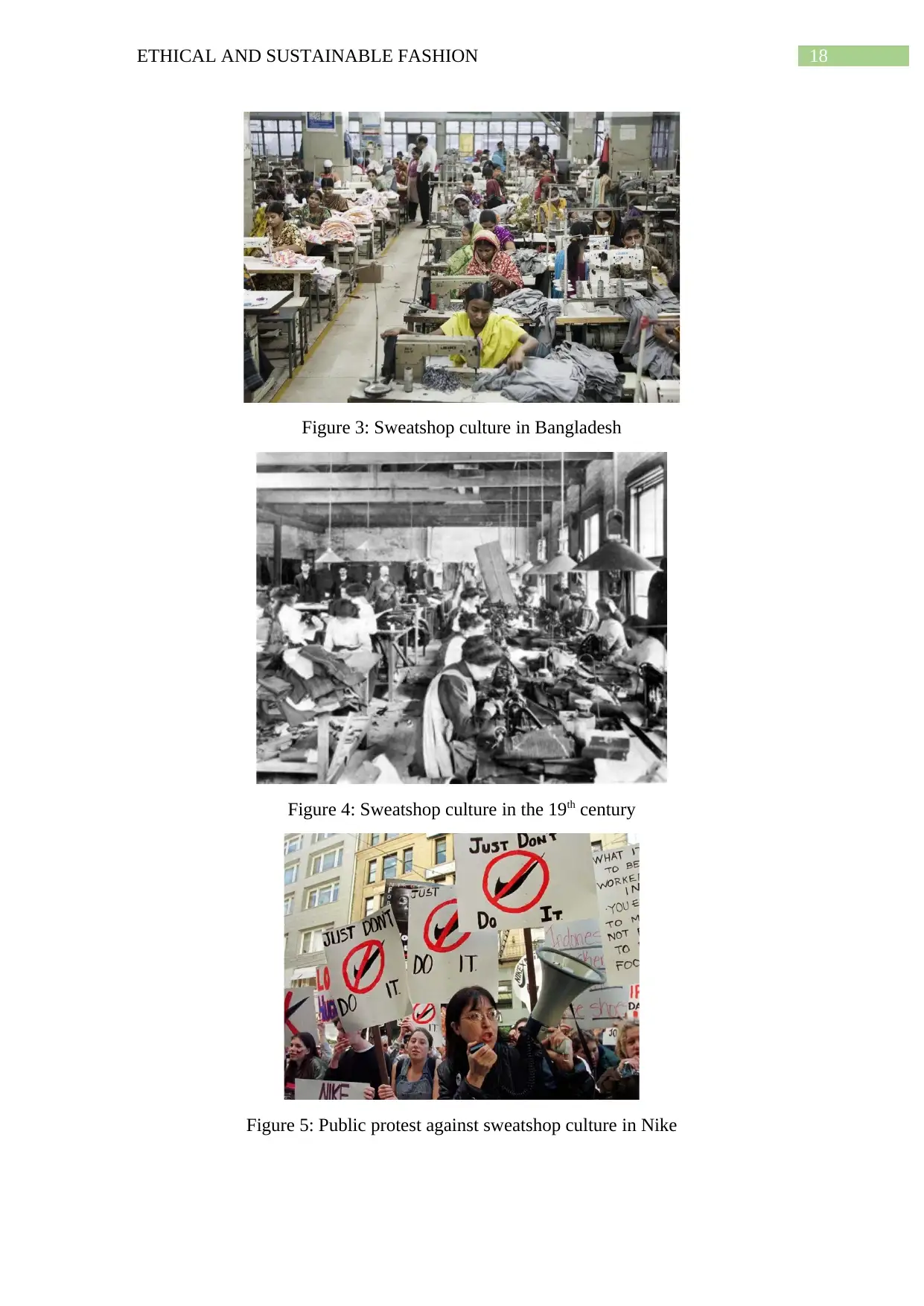
18ETHICAL AND SUSTAINABLE FASHION
Figure 3: Sweatshop culture in Bangladesh
Figure 4: Sweatshop culture in the 19th century
Figure 5: Public protest against sweatshop culture in Nike
Figure 3: Sweatshop culture in Bangladesh
Figure 4: Sweatshop culture in the 19th century
Figure 5: Public protest against sweatshop culture in Nike
Paraphrase This Document
Need a fresh take? Get an instant paraphrase of this document with our AI Paraphraser
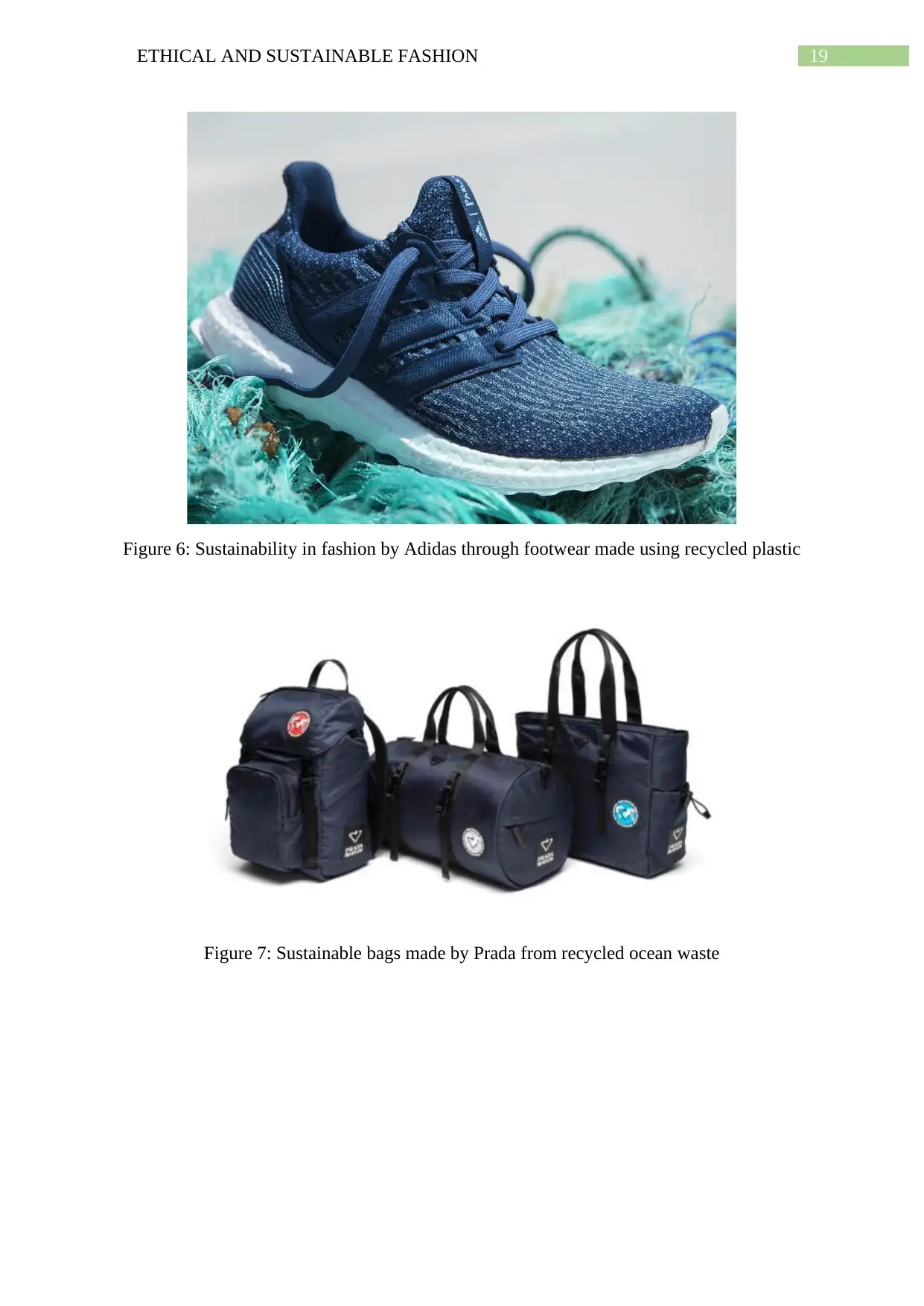
19ETHICAL AND SUSTAINABLE FASHION
Figure 6: Sustainability in fashion by Adidas through footwear made using recycled plastic
Figure 7: Sustainable bags made by Prada from recycled ocean waste
Figure 6: Sustainability in fashion by Adidas through footwear made using recycled plastic
Figure 7: Sustainable bags made by Prada from recycled ocean waste
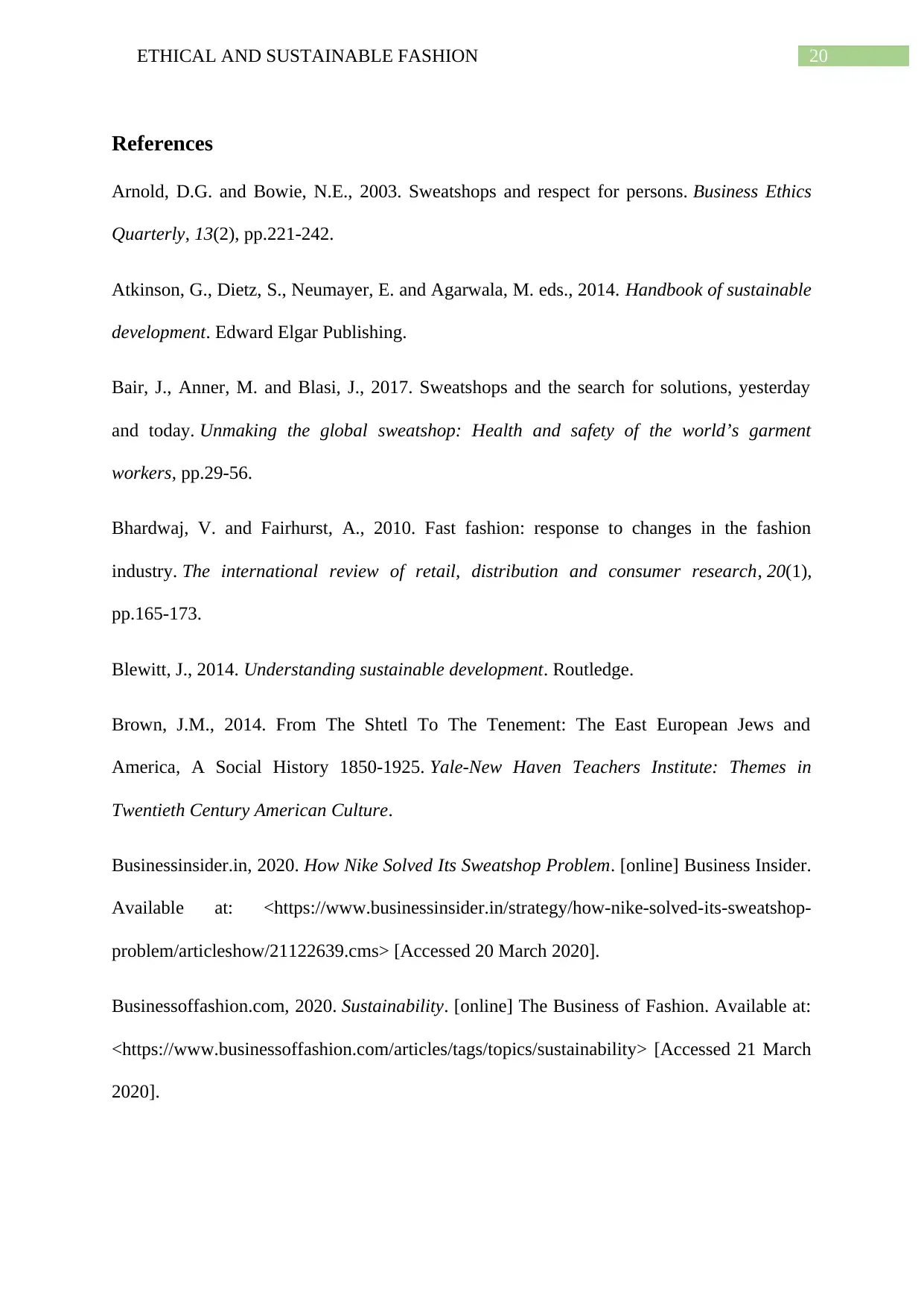
20ETHICAL AND SUSTAINABLE FASHION
References
Arnold, D.G. and Bowie, N.E., 2003. Sweatshops and respect for persons. Business Ethics
Quarterly, 13(2), pp.221-242.
Atkinson, G., Dietz, S., Neumayer, E. and Agarwala, M. eds., 2014. Handbook of sustainable
development. Edward Elgar Publishing.
Bair, J., Anner, M. and Blasi, J., 2017. Sweatshops and the search for solutions, yesterday
and today. Unmaking the global sweatshop: Health and safety of the world’s garment
workers, pp.29-56.
Bhardwaj, V. and Fairhurst, A., 2010. Fast fashion: response to changes in the fashion
industry. The international review of retail, distribution and consumer research, 20(1),
pp.165-173.
Blewitt, J., 2014. Understanding sustainable development. Routledge.
Brown, J.M., 2014. From The Shtetl To The Tenement: The East European Jews and
America, A Social History 1850-1925. Yale-New Haven Teachers Institute: Themes in
Twentieth Century American Culture.
Businessinsider.in, 2020. How Nike Solved Its Sweatshop Problem. [online] Business Insider.
Available at: <https://www.businessinsider.in/strategy/how-nike-solved-its-sweatshop-
problem/articleshow/21122639.cms> [Accessed 20 March 2020].
Businessoffashion.com, 2020. Sustainability. [online] The Business of Fashion. Available at:
<https://www.businessoffashion.com/articles/tags/topics/sustainability> [Accessed 21 March
2020].
References
Arnold, D.G. and Bowie, N.E., 2003. Sweatshops and respect for persons. Business Ethics
Quarterly, 13(2), pp.221-242.
Atkinson, G., Dietz, S., Neumayer, E. and Agarwala, M. eds., 2014. Handbook of sustainable
development. Edward Elgar Publishing.
Bair, J., Anner, M. and Blasi, J., 2017. Sweatshops and the search for solutions, yesterday
and today. Unmaking the global sweatshop: Health and safety of the world’s garment
workers, pp.29-56.
Bhardwaj, V. and Fairhurst, A., 2010. Fast fashion: response to changes in the fashion
industry. The international review of retail, distribution and consumer research, 20(1),
pp.165-173.
Blewitt, J., 2014. Understanding sustainable development. Routledge.
Brown, J.M., 2014. From The Shtetl To The Tenement: The East European Jews and
America, A Social History 1850-1925. Yale-New Haven Teachers Institute: Themes in
Twentieth Century American Culture.
Businessinsider.in, 2020. How Nike Solved Its Sweatshop Problem. [online] Business Insider.
Available at: <https://www.businessinsider.in/strategy/how-nike-solved-its-sweatshop-
problem/articleshow/21122639.cms> [Accessed 20 March 2020].
Businessoffashion.com, 2020. Sustainability. [online] The Business of Fashion. Available at:
<https://www.businessoffashion.com/articles/tags/topics/sustainability> [Accessed 21 March
2020].
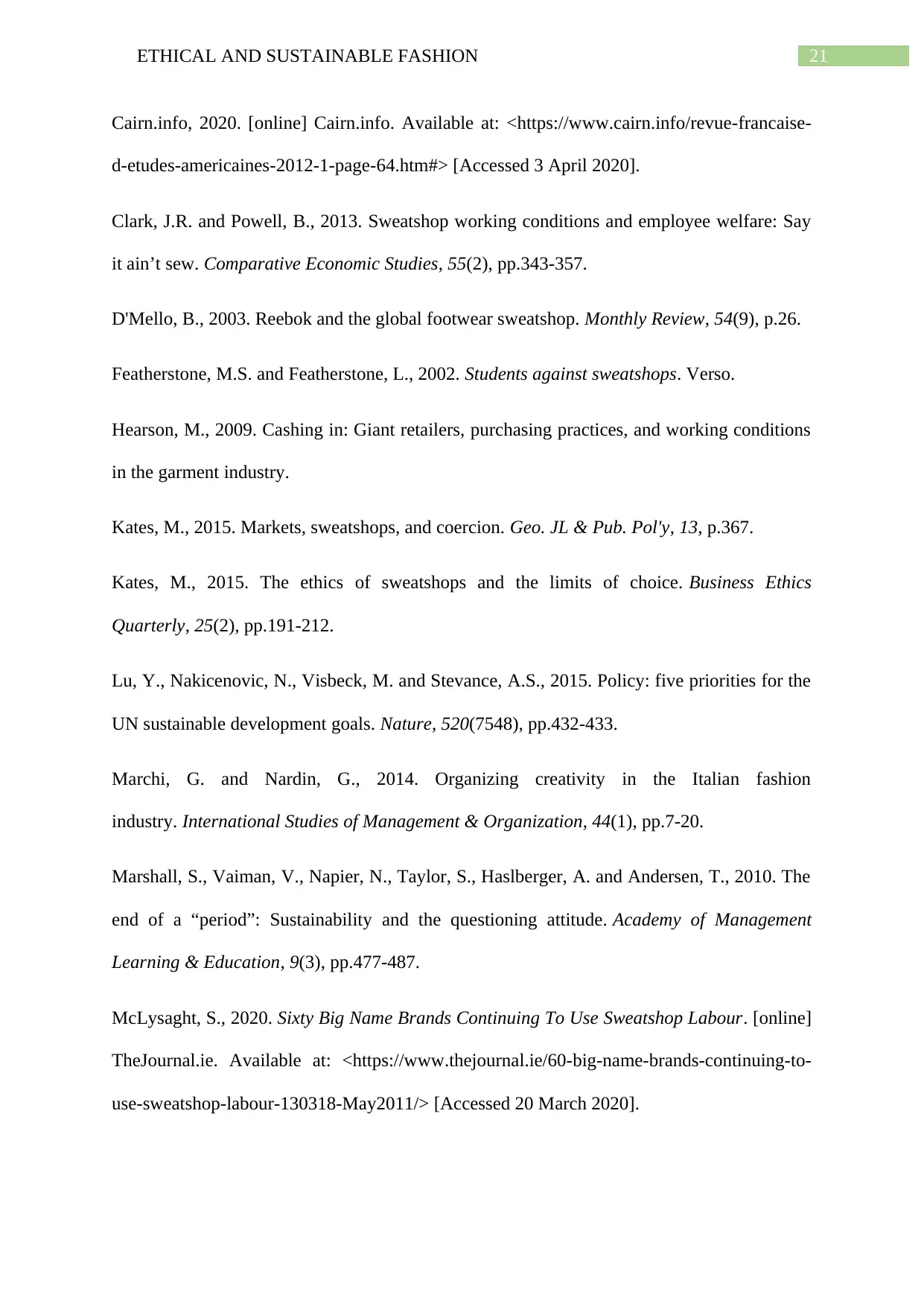
21ETHICAL AND SUSTAINABLE FASHION
Cairn.info, 2020. [online] Cairn.info. Available at: <https://www.cairn.info/revue-francaise-
d-etudes-americaines-2012-1-page-64.htm#> [Accessed 3 April 2020].
Clark, J.R. and Powell, B., 2013. Sweatshop working conditions and employee welfare: Say
it ain’t sew. Comparative Economic Studies, 55(2), pp.343-357.
D'Mello, B., 2003. Reebok and the global footwear sweatshop. Monthly Review, 54(9), p.26.
Featherstone, M.S. and Featherstone, L., 2002. Students against sweatshops. Verso.
Hearson, M., 2009. Cashing in: Giant retailers, purchasing practices, and working conditions
in the garment industry.
Kates, M., 2015. Markets, sweatshops, and coercion. Geo. JL & Pub. Pol'y, 13, p.367.
Kates, M., 2015. The ethics of sweatshops and the limits of choice. Business Ethics
Quarterly, 25(2), pp.191-212.
Lu, Y., Nakicenovic, N., Visbeck, M. and Stevance, A.S., 2015. Policy: five priorities for the
UN sustainable development goals. Nature, 520(7548), pp.432-433.
Marchi, G. and Nardin, G., 2014. Organizing creativity in the Italian fashion
industry. International Studies of Management & Organization, 44(1), pp.7-20.
Marshall, S., Vaiman, V., Napier, N., Taylor, S., Haslberger, A. and Andersen, T., 2010. The
end of a “period”: Sustainability and the questioning attitude. Academy of Management
Learning & Education, 9(3), pp.477-487.
McLysaght, S., 2020. Sixty Big Name Brands Continuing To Use Sweatshop Labour. [online]
TheJournal.ie. Available at: <https://www.thejournal.ie/60-big-name-brands-continuing-to-
use-sweatshop-labour-130318-May2011/> [Accessed 20 March 2020].
Cairn.info, 2020. [online] Cairn.info. Available at: <https://www.cairn.info/revue-francaise-
d-etudes-americaines-2012-1-page-64.htm#> [Accessed 3 April 2020].
Clark, J.R. and Powell, B., 2013. Sweatshop working conditions and employee welfare: Say
it ain’t sew. Comparative Economic Studies, 55(2), pp.343-357.
D'Mello, B., 2003. Reebok and the global footwear sweatshop. Monthly Review, 54(9), p.26.
Featherstone, M.S. and Featherstone, L., 2002. Students against sweatshops. Verso.
Hearson, M., 2009. Cashing in: Giant retailers, purchasing practices, and working conditions
in the garment industry.
Kates, M., 2015. Markets, sweatshops, and coercion. Geo. JL & Pub. Pol'y, 13, p.367.
Kates, M., 2015. The ethics of sweatshops and the limits of choice. Business Ethics
Quarterly, 25(2), pp.191-212.
Lu, Y., Nakicenovic, N., Visbeck, M. and Stevance, A.S., 2015. Policy: five priorities for the
UN sustainable development goals. Nature, 520(7548), pp.432-433.
Marchi, G. and Nardin, G., 2014. Organizing creativity in the Italian fashion
industry. International Studies of Management & Organization, 44(1), pp.7-20.
Marshall, S., Vaiman, V., Napier, N., Taylor, S., Haslberger, A. and Andersen, T., 2010. The
end of a “period”: Sustainability and the questioning attitude. Academy of Management
Learning & Education, 9(3), pp.477-487.
McLysaght, S., 2020. Sixty Big Name Brands Continuing To Use Sweatshop Labour. [online]
TheJournal.ie. Available at: <https://www.thejournal.ie/60-big-name-brands-continuing-to-
use-sweatshop-labour-130318-May2011/> [Accessed 20 March 2020].
Secure Best Marks with AI Grader
Need help grading? Try our AI Grader for instant feedback on your assignments.
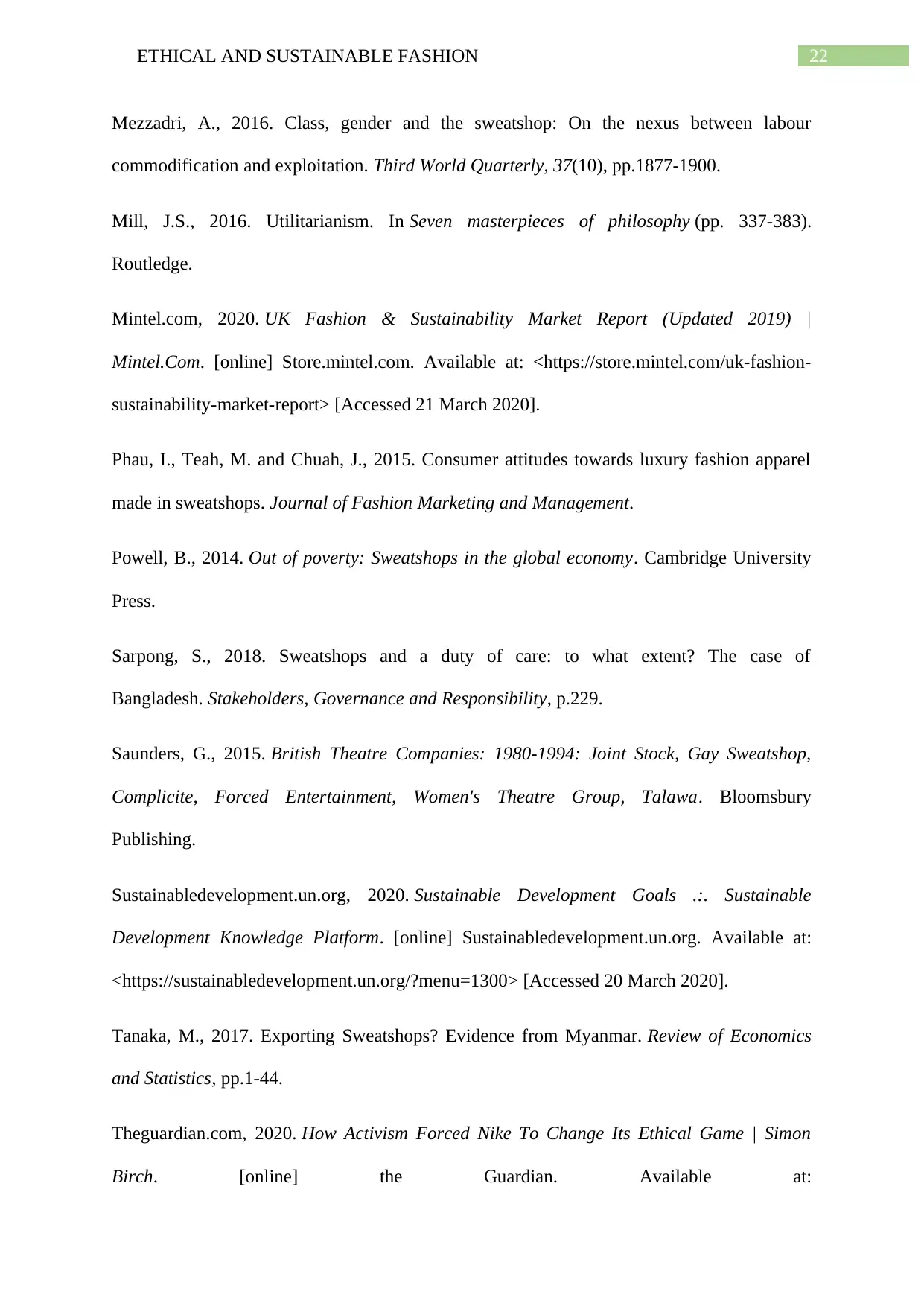
22ETHICAL AND SUSTAINABLE FASHION
Mezzadri, A., 2016. Class, gender and the sweatshop: On the nexus between labour
commodification and exploitation. Third World Quarterly, 37(10), pp.1877-1900.
Mill, J.S., 2016. Utilitarianism. In Seven masterpieces of philosophy (pp. 337-383).
Routledge.
Mintel.com, 2020. UK Fashion & Sustainability Market Report (Updated 2019) |
Mintel.Com. [online] Store.mintel.com. Available at: <https://store.mintel.com/uk-fashion-
sustainability-market-report> [Accessed 21 March 2020].
Phau, I., Teah, M. and Chuah, J., 2015. Consumer attitudes towards luxury fashion apparel
made in sweatshops. Journal of Fashion Marketing and Management.
Powell, B., 2014. Out of poverty: Sweatshops in the global economy. Cambridge University
Press.
Sarpong, S., 2018. Sweatshops and a duty of care: to what extent? The case of
Bangladesh. Stakeholders, Governance and Responsibility, p.229.
Saunders, G., 2015. British Theatre Companies: 1980-1994: Joint Stock, Gay Sweatshop,
Complicite, Forced Entertainment, Women's Theatre Group, Talawa. Bloomsbury
Publishing.
Sustainabledevelopment.un.org, 2020. Sustainable Development Goals .:. Sustainable
Development Knowledge Platform. [online] Sustainabledevelopment.un.org. Available at:
<https://sustainabledevelopment.un.org/?menu=1300> [Accessed 20 March 2020].
Tanaka, M., 2017. Exporting Sweatshops? Evidence from Myanmar. Review of Economics
and Statistics, pp.1-44.
Theguardian.com, 2020. How Activism Forced Nike To Change Its Ethical Game | Simon
Birch. [online] the Guardian. Available at:
Mezzadri, A., 2016. Class, gender and the sweatshop: On the nexus between labour
commodification and exploitation. Third World Quarterly, 37(10), pp.1877-1900.
Mill, J.S., 2016. Utilitarianism. In Seven masterpieces of philosophy (pp. 337-383).
Routledge.
Mintel.com, 2020. UK Fashion & Sustainability Market Report (Updated 2019) |
Mintel.Com. [online] Store.mintel.com. Available at: <https://store.mintel.com/uk-fashion-
sustainability-market-report> [Accessed 21 March 2020].
Phau, I., Teah, M. and Chuah, J., 2015. Consumer attitudes towards luxury fashion apparel
made in sweatshops. Journal of Fashion Marketing and Management.
Powell, B., 2014. Out of poverty: Sweatshops in the global economy. Cambridge University
Press.
Sarpong, S., 2018. Sweatshops and a duty of care: to what extent? The case of
Bangladesh. Stakeholders, Governance and Responsibility, p.229.
Saunders, G., 2015. British Theatre Companies: 1980-1994: Joint Stock, Gay Sweatshop,
Complicite, Forced Entertainment, Women's Theatre Group, Talawa. Bloomsbury
Publishing.
Sustainabledevelopment.un.org, 2020. Sustainable Development Goals .:. Sustainable
Development Knowledge Platform. [online] Sustainabledevelopment.un.org. Available at:
<https://sustainabledevelopment.un.org/?menu=1300> [Accessed 20 March 2020].
Tanaka, M., 2017. Exporting Sweatshops? Evidence from Myanmar. Review of Economics
and Statistics, pp.1-44.
Theguardian.com, 2020. How Activism Forced Nike To Change Its Ethical Game | Simon
Birch. [online] the Guardian. Available at:
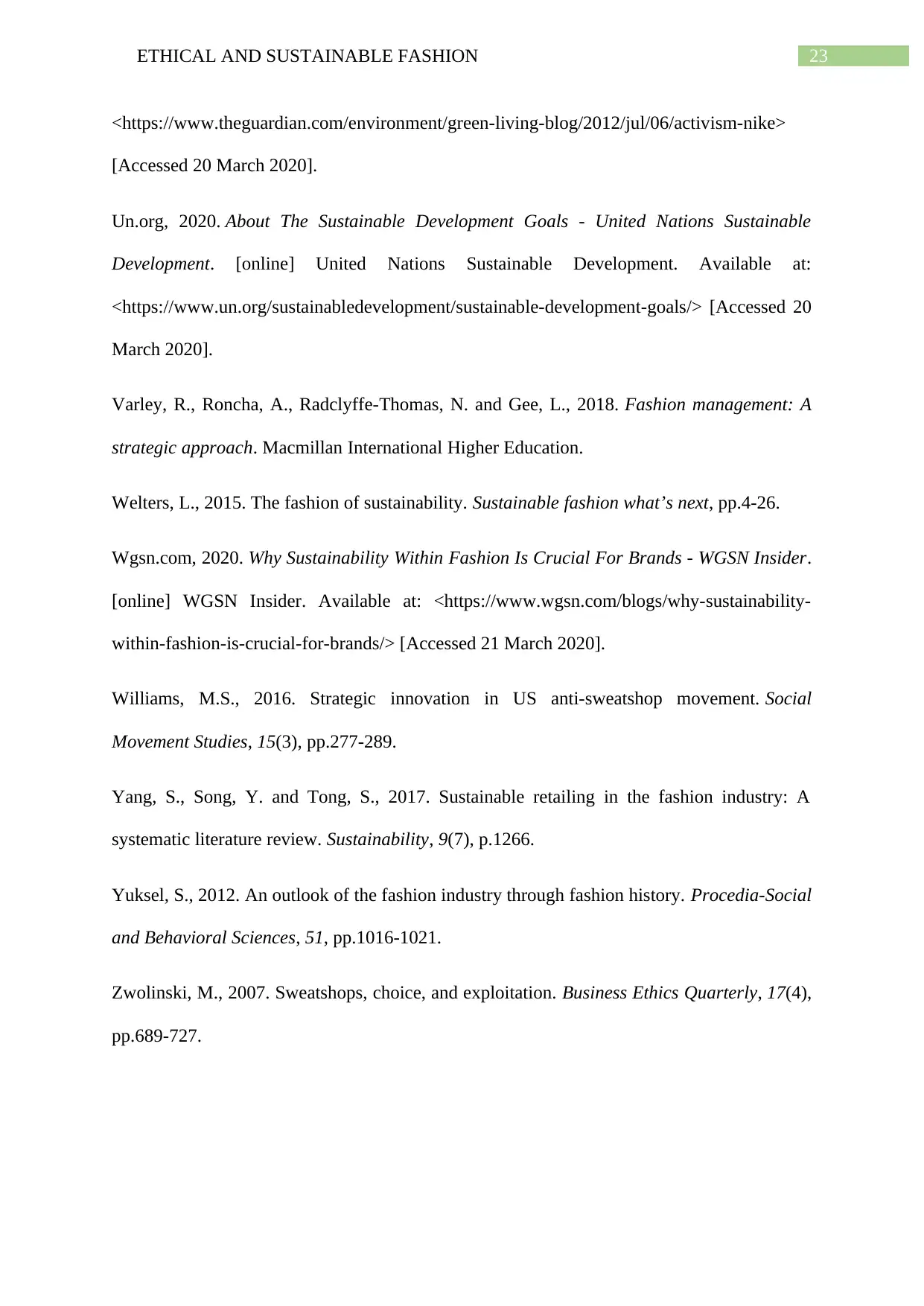
23ETHICAL AND SUSTAINABLE FASHION
<https://www.theguardian.com/environment/green-living-blog/2012/jul/06/activism-nike>
[Accessed 20 March 2020].
Un.org, 2020. About The Sustainable Development Goals - United Nations Sustainable
Development. [online] United Nations Sustainable Development. Available at:
<https://www.un.org/sustainabledevelopment/sustainable-development-goals/> [Accessed 20
March 2020].
Varley, R., Roncha, A., Radclyffe-Thomas, N. and Gee, L., 2018. Fashion management: A
strategic approach. Macmillan International Higher Education.
Welters, L., 2015. The fashion of sustainability. Sustainable fashion what’s next, pp.4-26.
Wgsn.com, 2020. Why Sustainability Within Fashion Is Crucial For Brands - WGSN Insider.
[online] WGSN Insider. Available at: <https://www.wgsn.com/blogs/why-sustainability-
within-fashion-is-crucial-for-brands/> [Accessed 21 March 2020].
Williams, M.S., 2016. Strategic innovation in US anti-sweatshop movement. Social
Movement Studies, 15(3), pp.277-289.
Yang, S., Song, Y. and Tong, S., 2017. Sustainable retailing in the fashion industry: A
systematic literature review. Sustainability, 9(7), p.1266.
Yuksel, S., 2012. An outlook of the fashion industry through fashion history. Procedia-Social
and Behavioral Sciences, 51, pp.1016-1021.
Zwolinski, M., 2007. Sweatshops, choice, and exploitation. Business Ethics Quarterly, 17(4),
pp.689-727.
<https://www.theguardian.com/environment/green-living-blog/2012/jul/06/activism-nike>
[Accessed 20 March 2020].
Un.org, 2020. About The Sustainable Development Goals - United Nations Sustainable
Development. [online] United Nations Sustainable Development. Available at:
<https://www.un.org/sustainabledevelopment/sustainable-development-goals/> [Accessed 20
March 2020].
Varley, R., Roncha, A., Radclyffe-Thomas, N. and Gee, L., 2018. Fashion management: A
strategic approach. Macmillan International Higher Education.
Welters, L., 2015. The fashion of sustainability. Sustainable fashion what’s next, pp.4-26.
Wgsn.com, 2020. Why Sustainability Within Fashion Is Crucial For Brands - WGSN Insider.
[online] WGSN Insider. Available at: <https://www.wgsn.com/blogs/why-sustainability-
within-fashion-is-crucial-for-brands/> [Accessed 21 March 2020].
Williams, M.S., 2016. Strategic innovation in US anti-sweatshop movement. Social
Movement Studies, 15(3), pp.277-289.
Yang, S., Song, Y. and Tong, S., 2017. Sustainable retailing in the fashion industry: A
systematic literature review. Sustainability, 9(7), p.1266.
Yuksel, S., 2012. An outlook of the fashion industry through fashion history. Procedia-Social
and Behavioral Sciences, 51, pp.1016-1021.
Zwolinski, M., 2007. Sweatshops, choice, and exploitation. Business Ethics Quarterly, 17(4),
pp.689-727.
1 out of 24
Related Documents
Your All-in-One AI-Powered Toolkit for Academic Success.
+13062052269
info@desklib.com
Available 24*7 on WhatsApp / Email
![[object Object]](/_next/static/media/star-bottom.7253800d.svg)
Unlock your academic potential
© 2024 | Zucol Services PVT LTD | All rights reserved.





